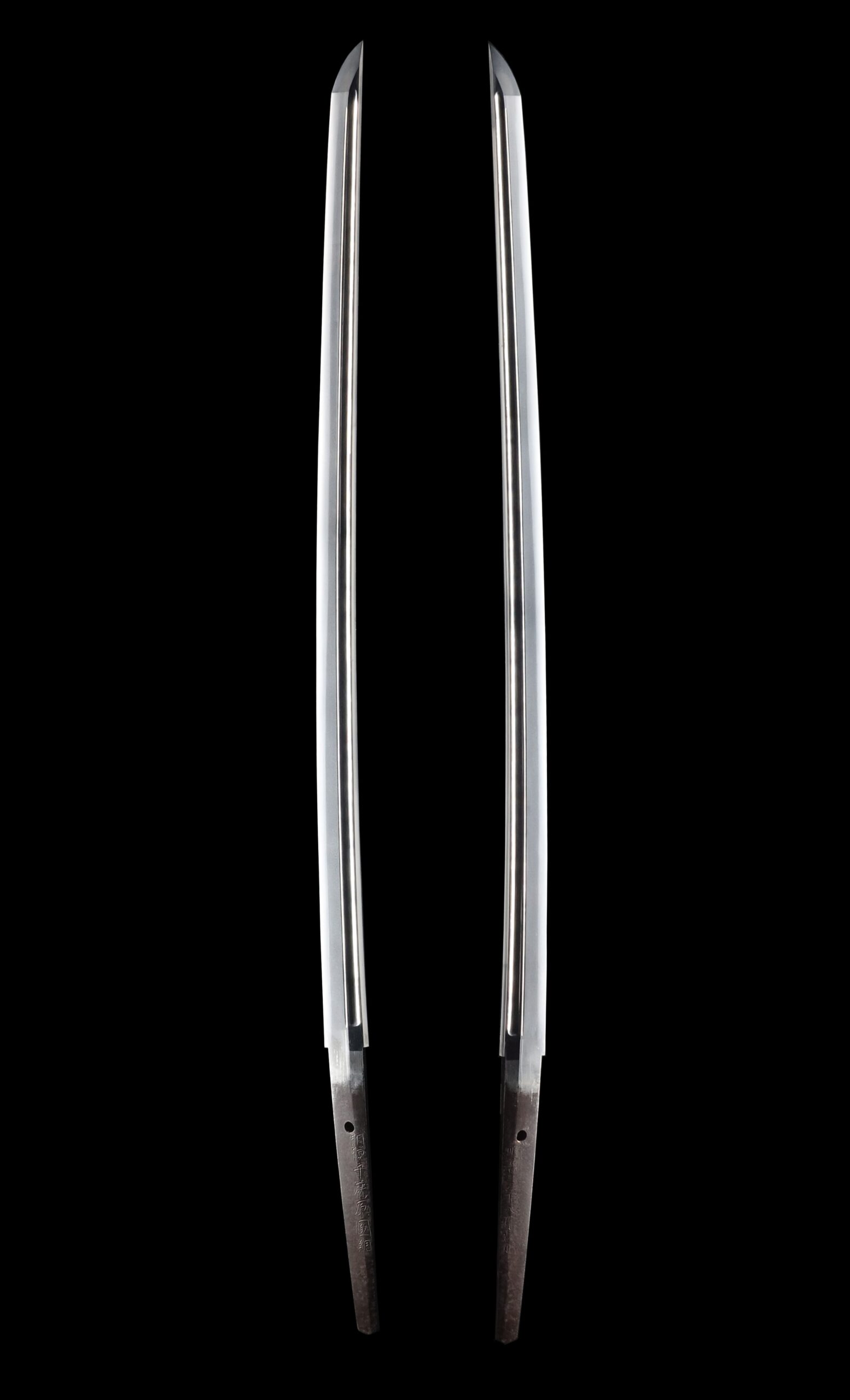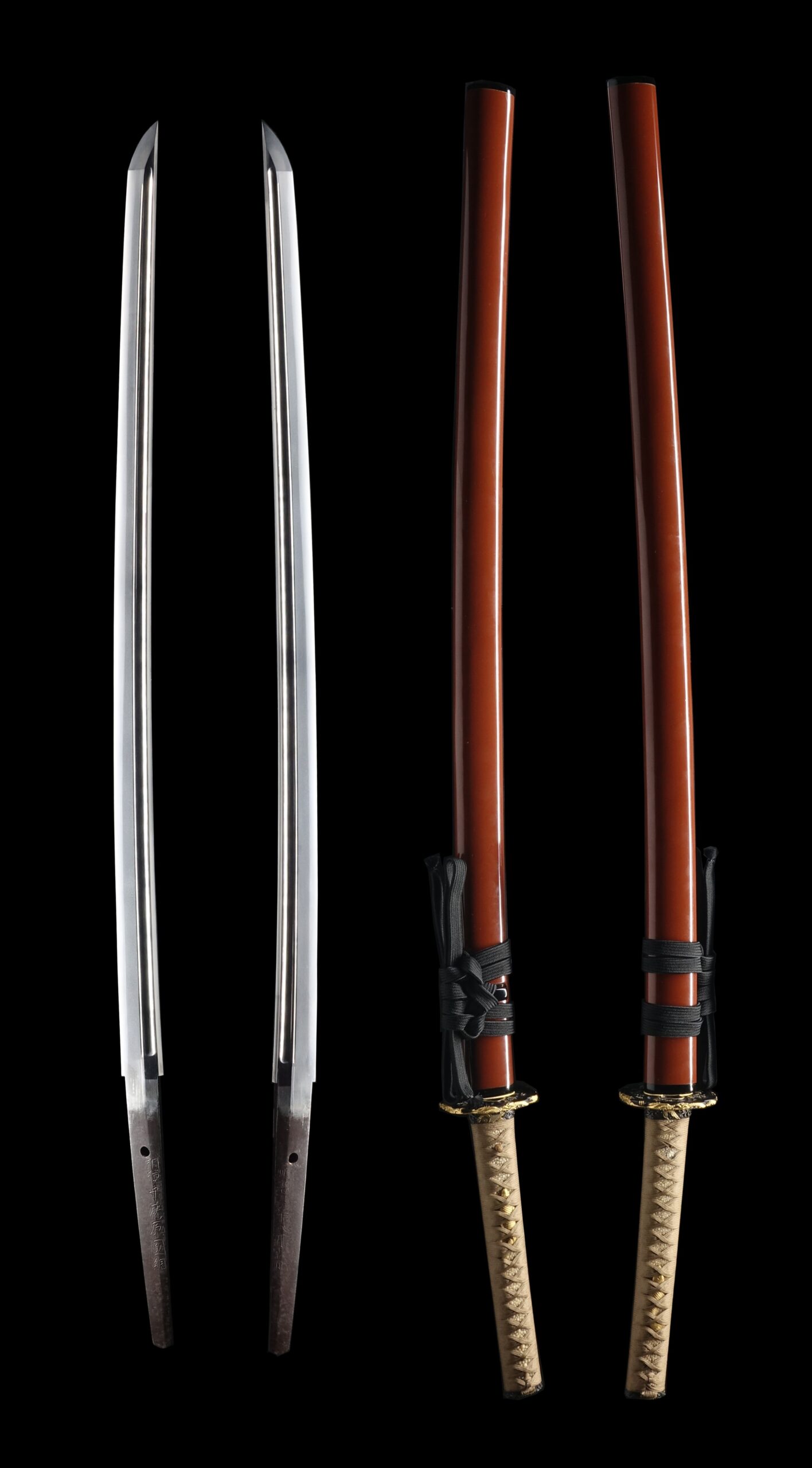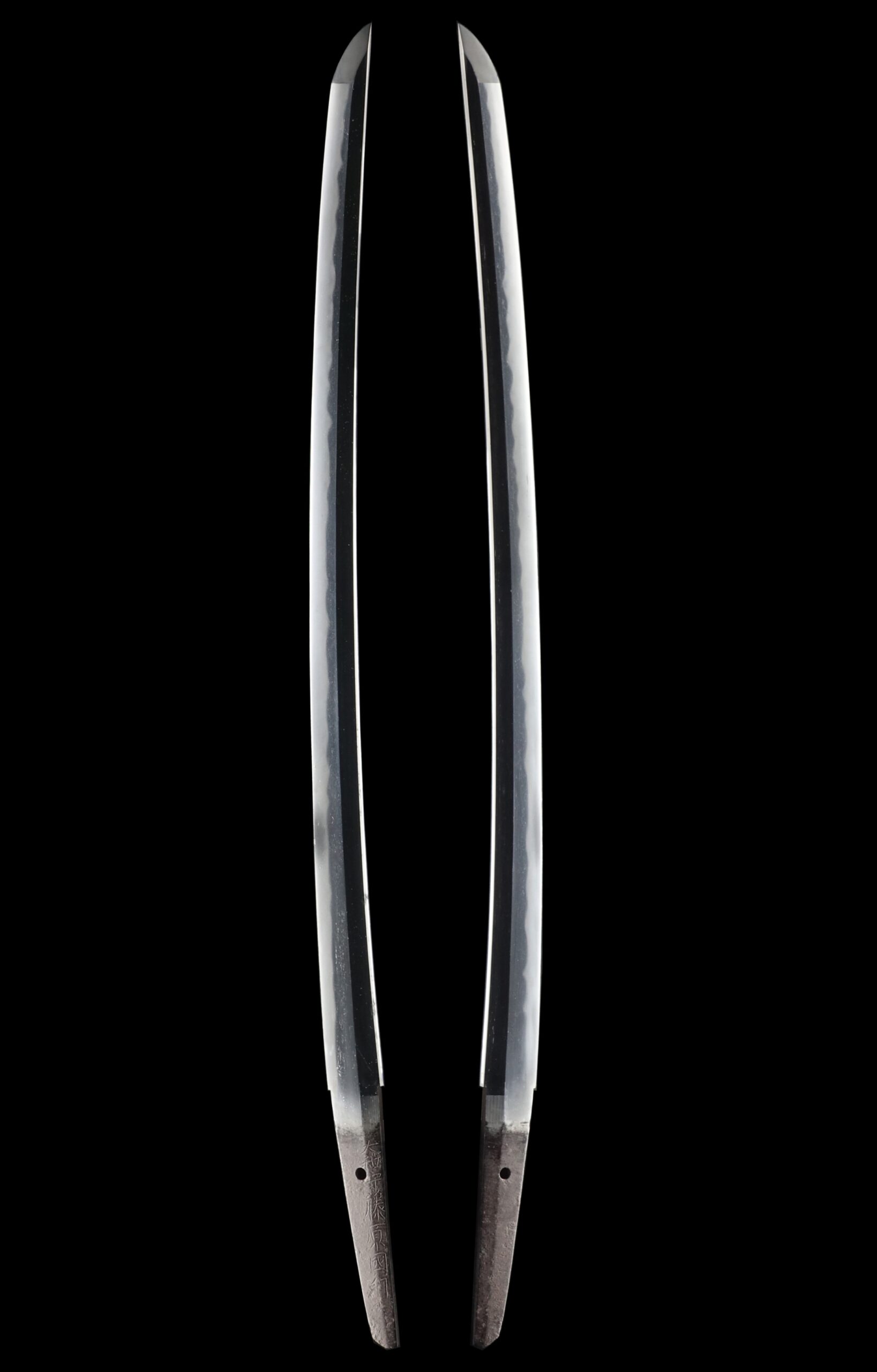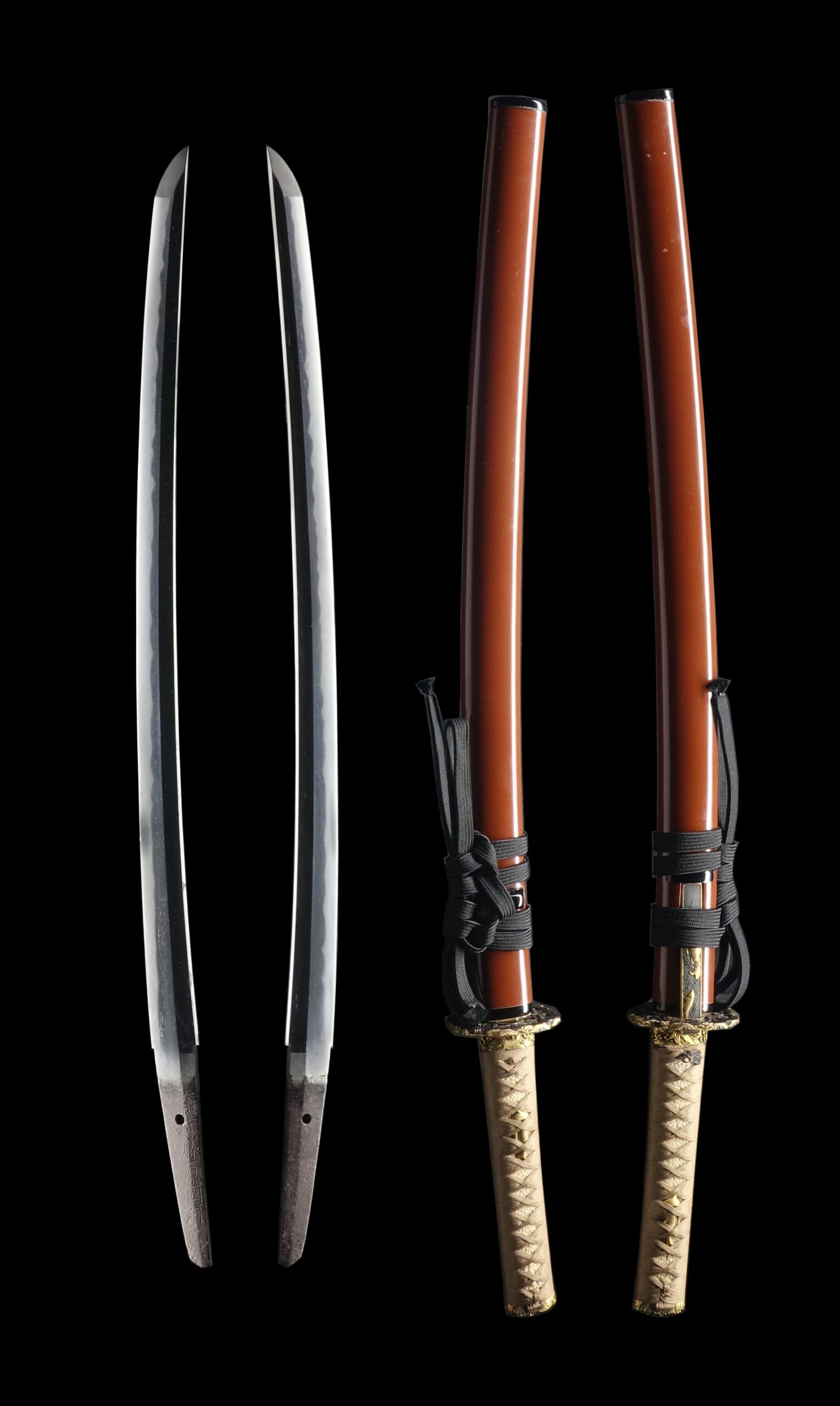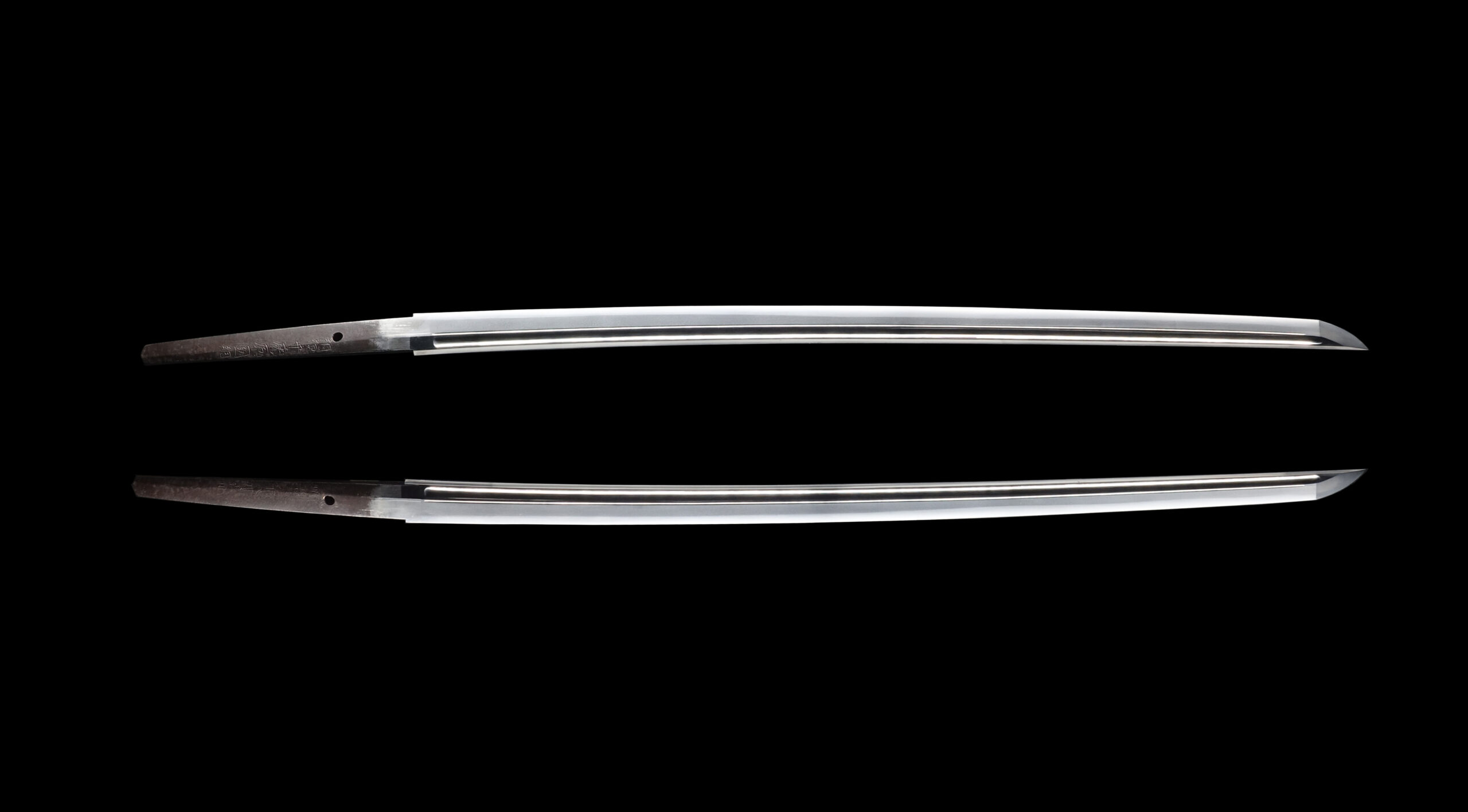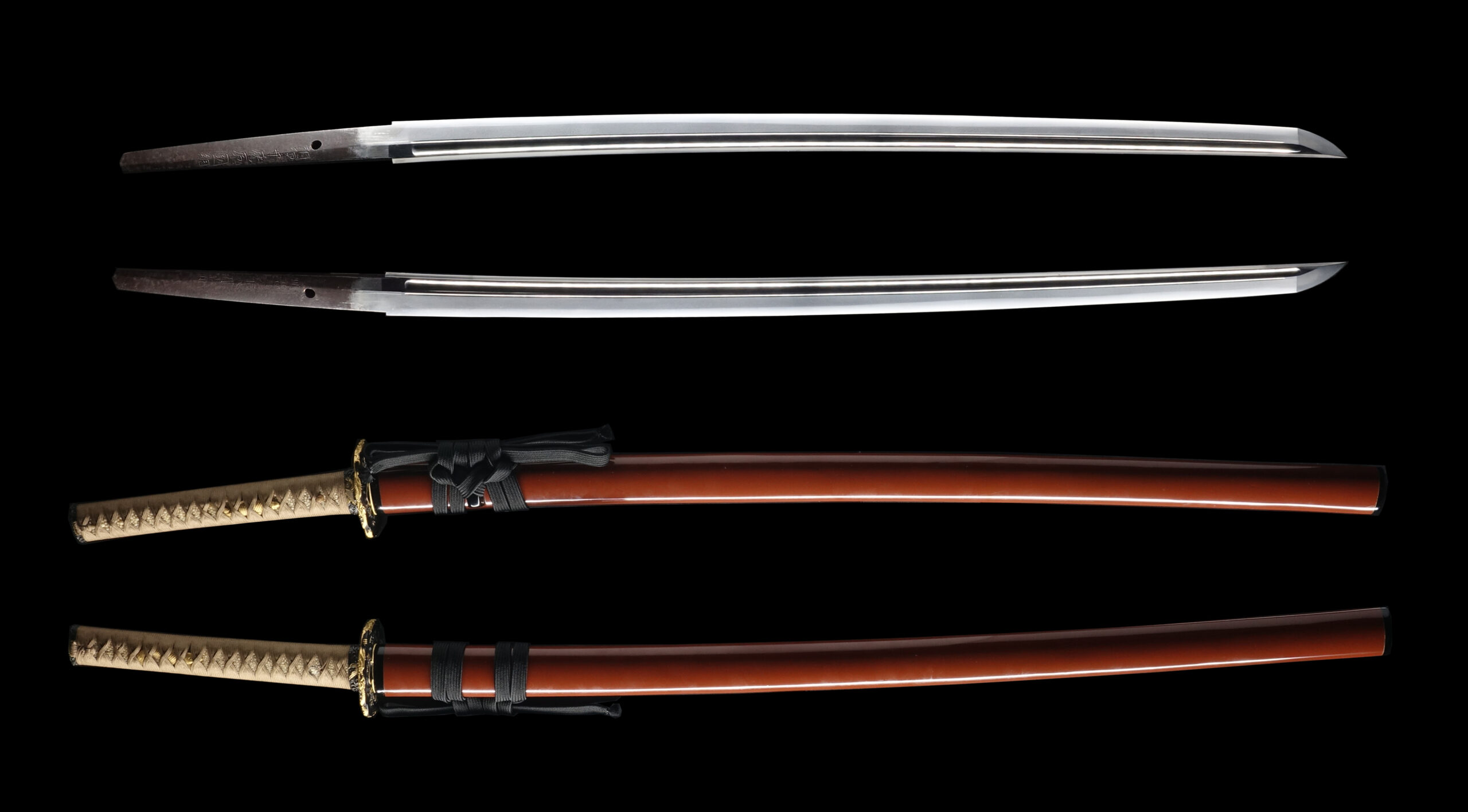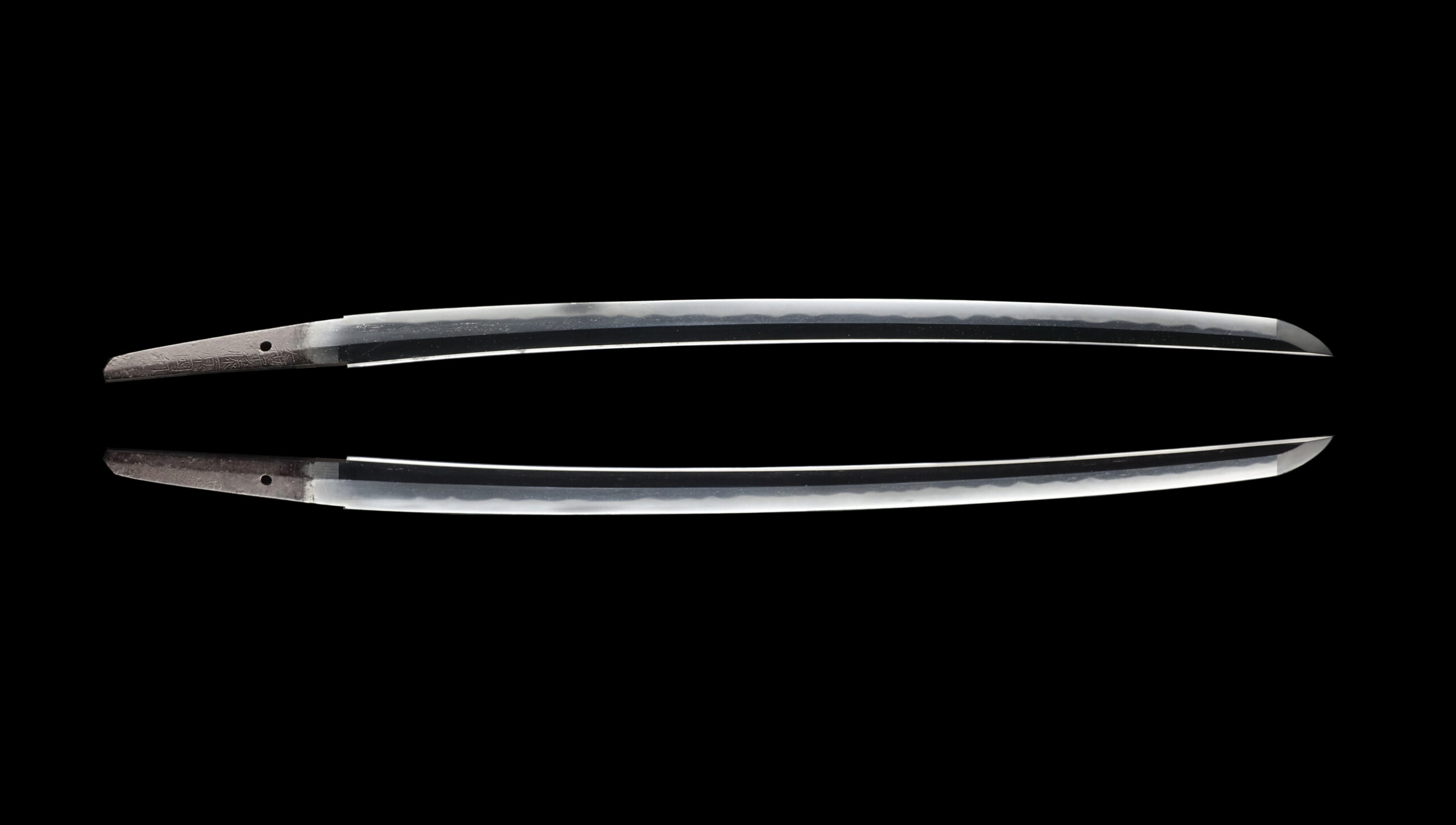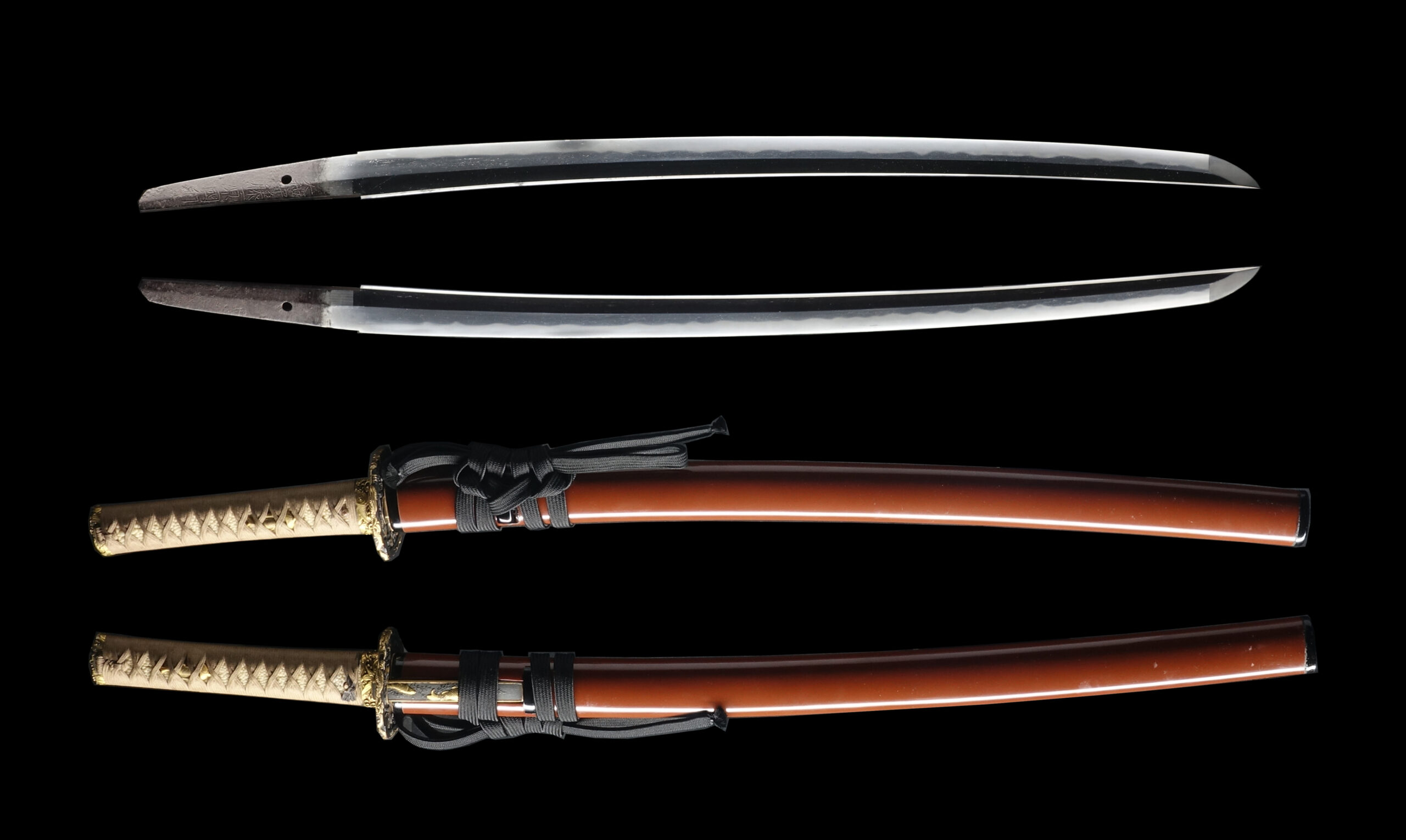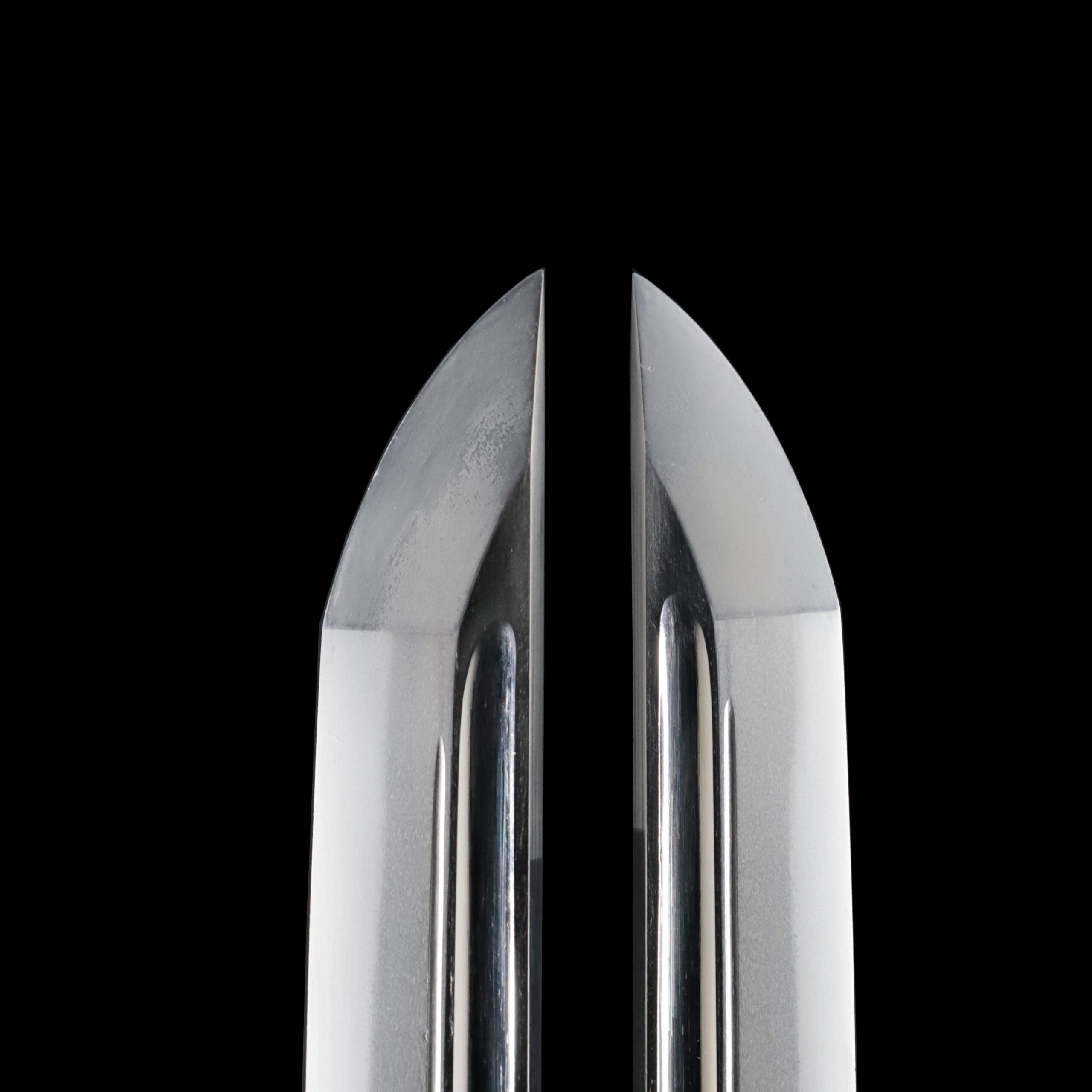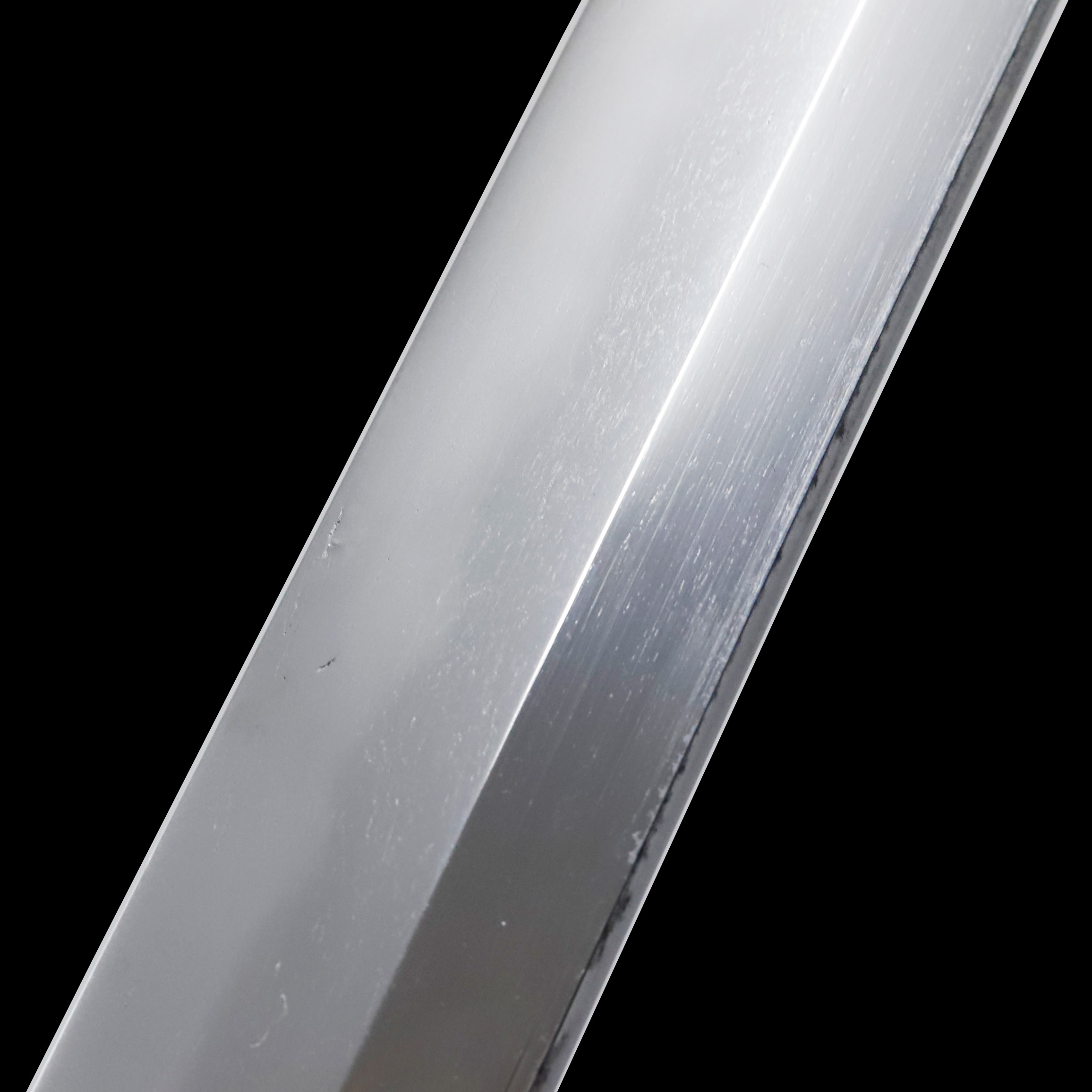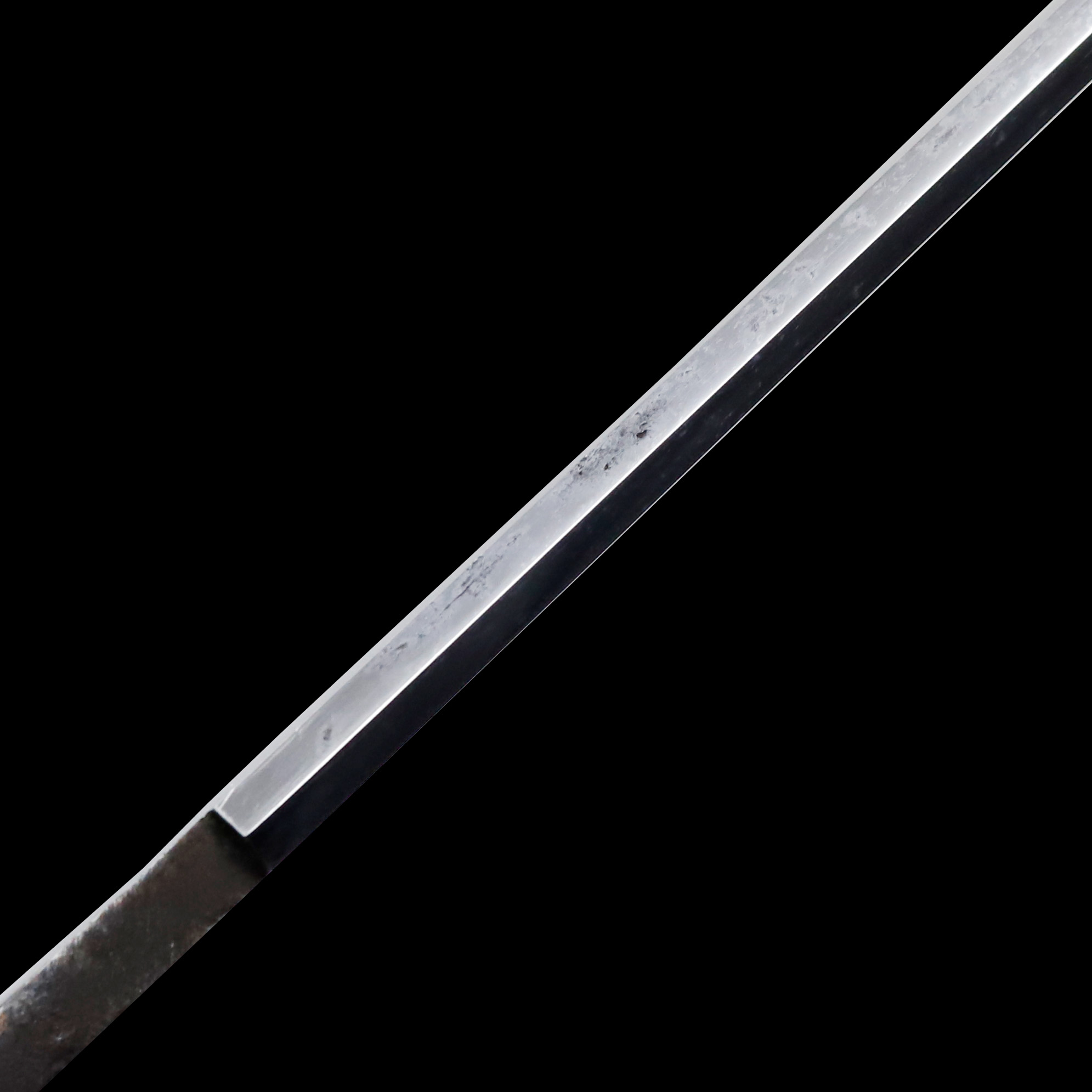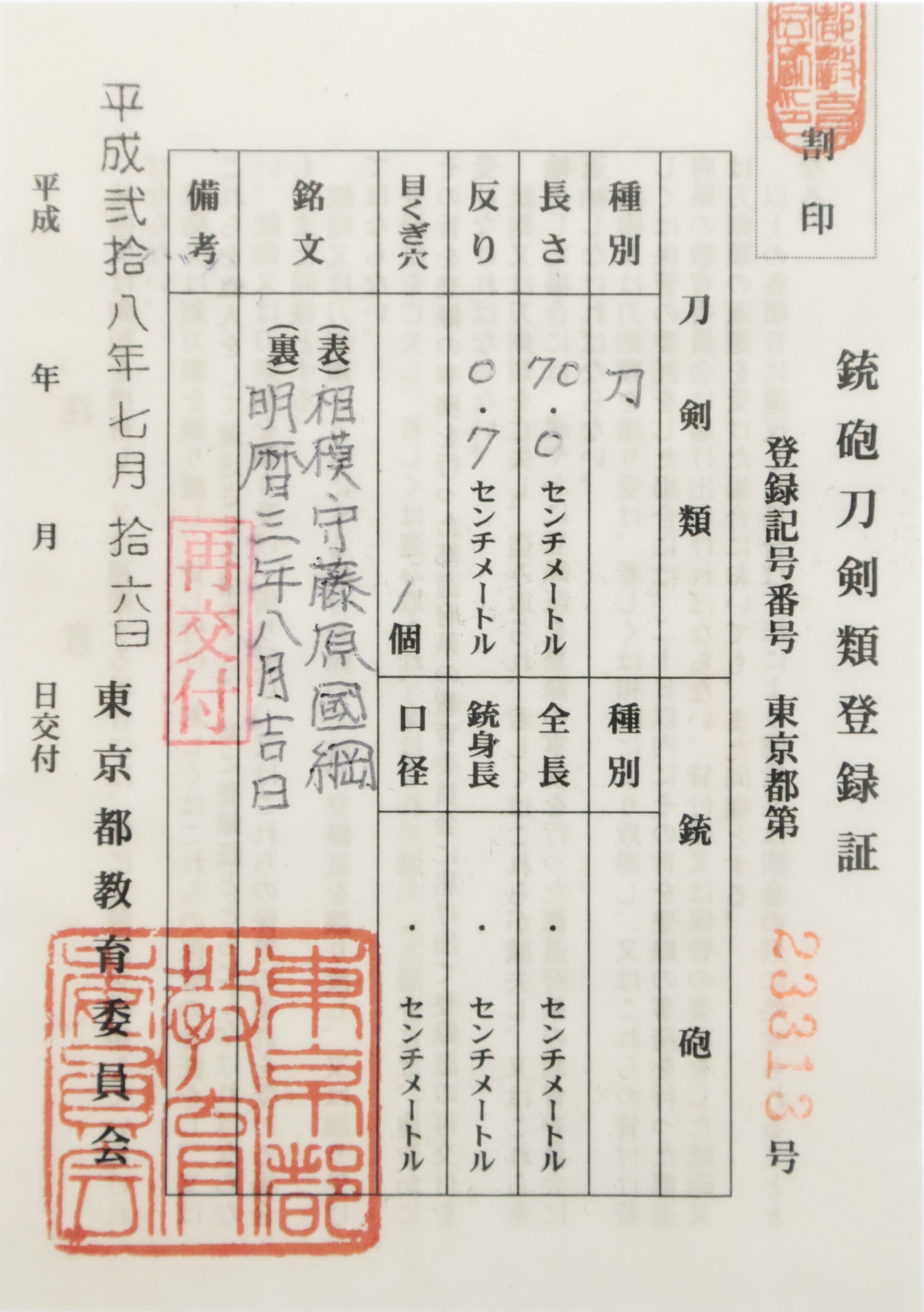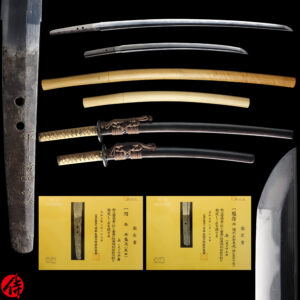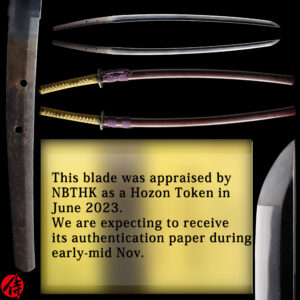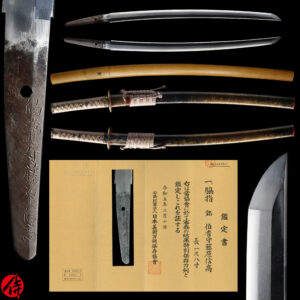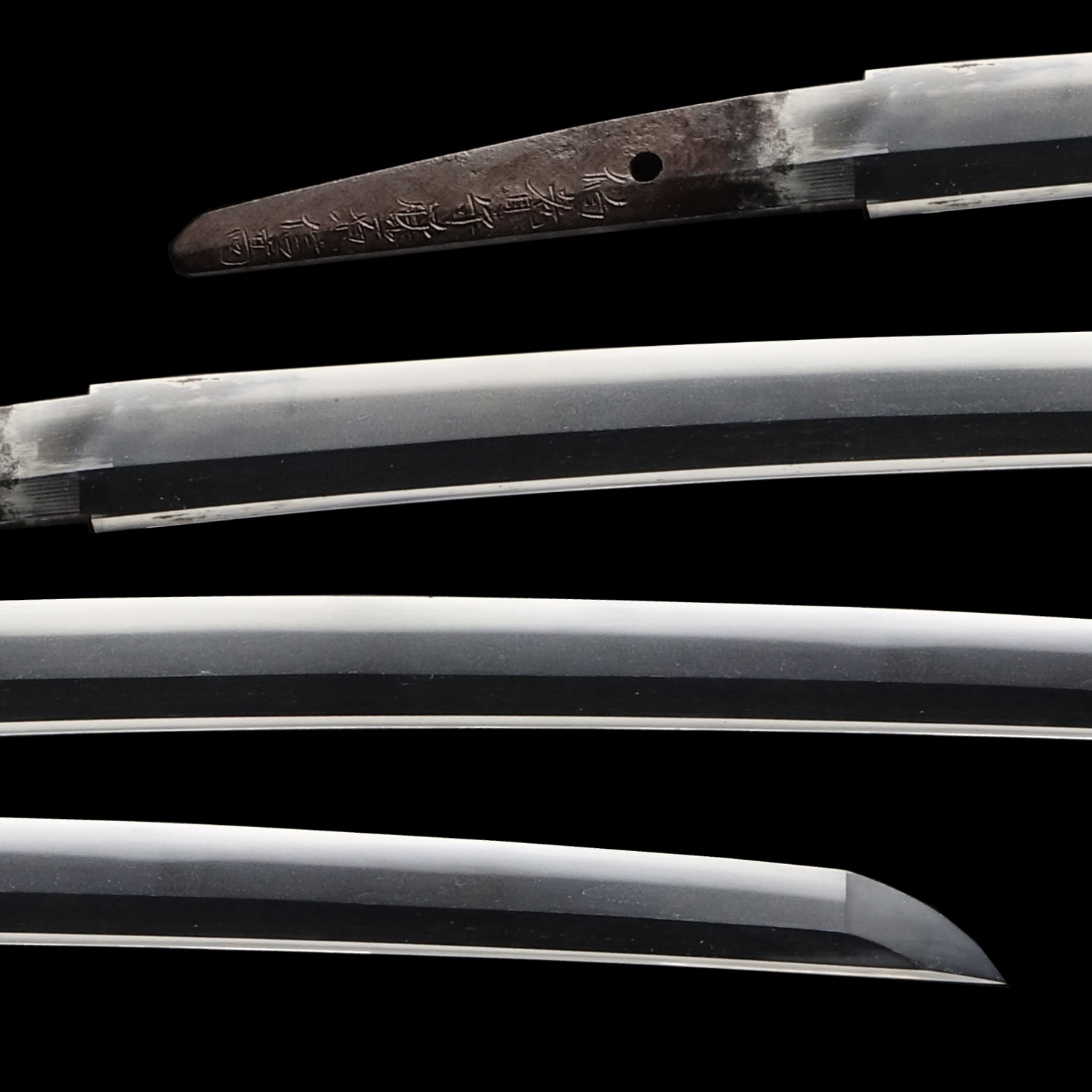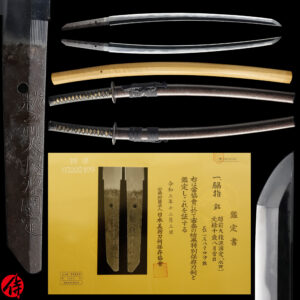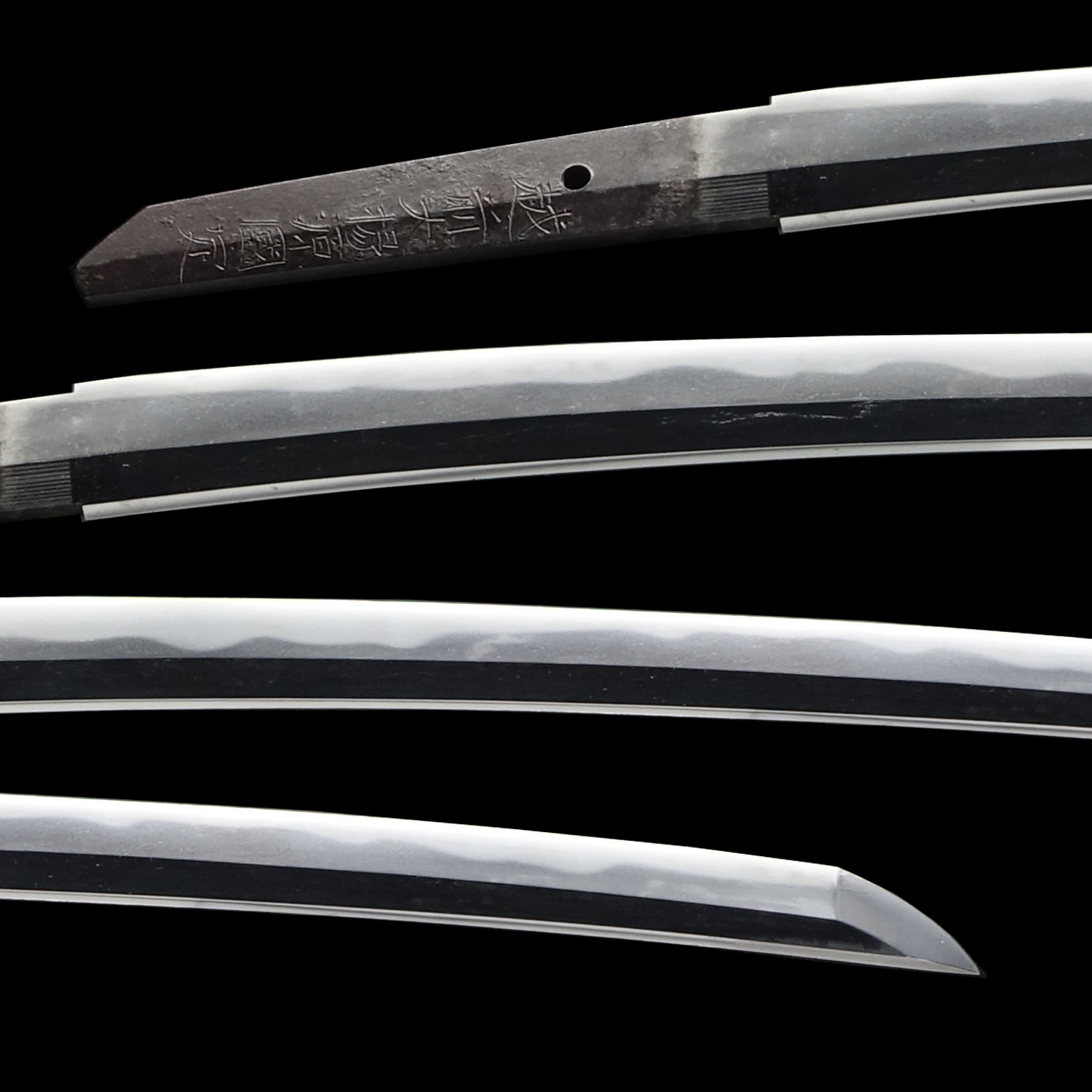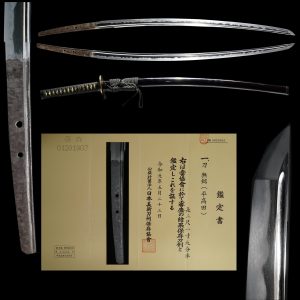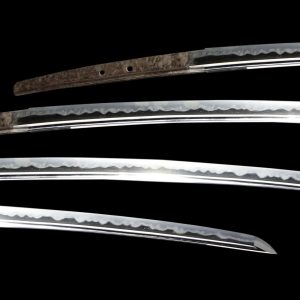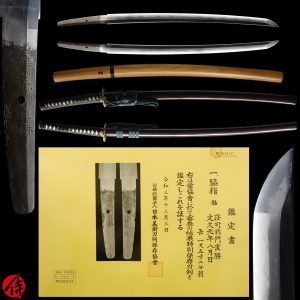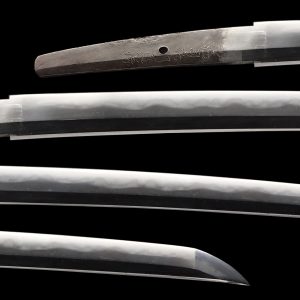Antique Japanese Sword Daisho Signed by Kunitsuna/ Kuniyuki with NBTHK Tokubetsu Hozon Certificate and Hozon Certificate
【Description】
-Katana
This blade was signed by Sagami no Kami Fujiwara Kunitsuna (相模守藤原国綱) in the third year of the Meireki era (1657: Earky Edo period). He was an apprentice of the first-gen Echizen Kanetane. He belonged to Shimosaka School located in Echizen province (Today’s Fukui prefecture). He is also known as Taheibei (多平兵衛). He received an honorable official title of Sagami no Kami from the imperial court for his excellent craftsmanship. He moved from Echizen to Edo city in his career as well.
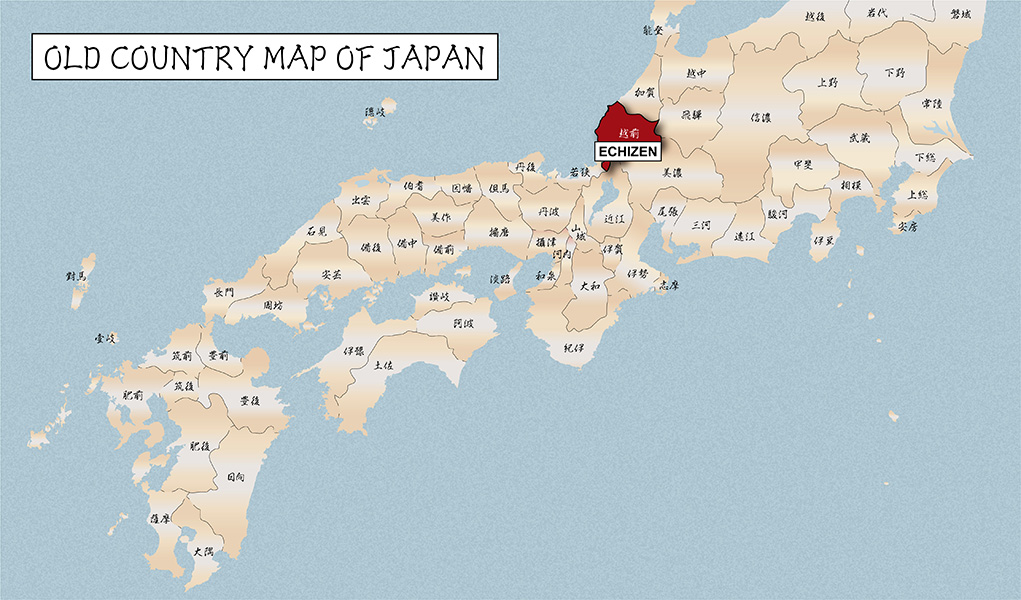
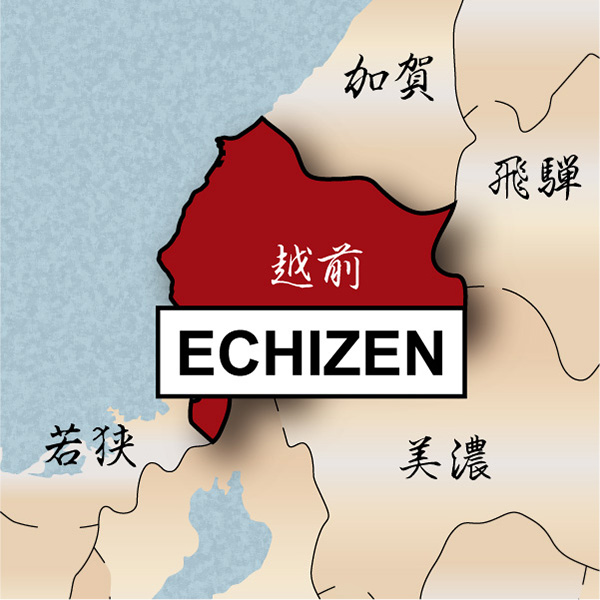
It is said that the first-gen Yasutsugu was the founder of the Echizen Shimoasaka school. He was born in Shimosaka town in Shiga prefecture at the end of the Muromachi period (Late 16 century ). He built his career there until the beginning of the Keicho era(1596). However, he moved to Echizen province due to the relocation of the lord he served. He eventually was noticed and supported by Matsudaira Hideyasu, the third son of Tokugawa Ieyasu, who was the founder of the Edo government.
Hideysu was the feudal lord of Echizen province during the early Edo period. With the support of Hideyasu, the first-gen Yasutsugu was able to establish the Echizen Shimosaka school. And his school’s fame became nationwide. By Hideyasu’s recommendation, the first-gen Yasutsugu became Okakaekaji for the Tokugawa shogun family, meaning that he exclusively forged swords for the Shogun family. Yasutsu was acknowledged by the first and second Tokugawa Shoguns, Tokugawa Ieyasu, and Tokugawa Hidetada.
The first-gen Yasutsugu received 康(YASU) from Tokugawa Ieyasu and changed his maker’s name. He was also allowed to inscribe the holly oak symbol(family crest of Tokugawa) on the tang. The school flourished during the Edo period and trained many skilled apprentices. We believe Kunitsuna mastered superb level of the craftsmanship by belonged to this school.
Echizen province was prosperous during the Edo period, being ruled by the Echizen Matsudaira clan, a direct retainer of Tokugawa clan who ruled the Edo government. Many skilled swordsmiths moved to Echizen from different regions because of high demand among Samurai who lived there. Among them, there were many renowned swordsmiths who were originally from the Mino province (Gifu prefecture). They are called Echizen Seki swordsmiths. His master, the first-gen Kanetane was one of them.
-Wakizashi
This blade was signed by Yamato no Kami Fujiwara Kuniyuki (大和守藤原国行), who belonged to a prestigious school named Takada (高田). He was active during the Kanbun era (1661-1673: Early Edo period). Kuniyuki played an important role to make Takada school prosperous during the Edo period. It is said that Kuniyuki served Ogyu Matsudaira clan, who ruled Funai castle in Oita prefecture. Ogyu Matsudaira clan was from Tokugawa Shogunate linage and Kuniyuki exclusively forged blades for this clan.
Takada school was founded by Takada Tomoyuki in Takada village, Bungo domain (Ohita prefecture), during the Nanbokucho period. (1334-1338 A.D). Takada Tomoyuki went to Bizen province(today’s Okayama prefecture) to master the sword-forging techniques of BIZEN and returned to the village and trained his apprentices. That is how Takada school started.
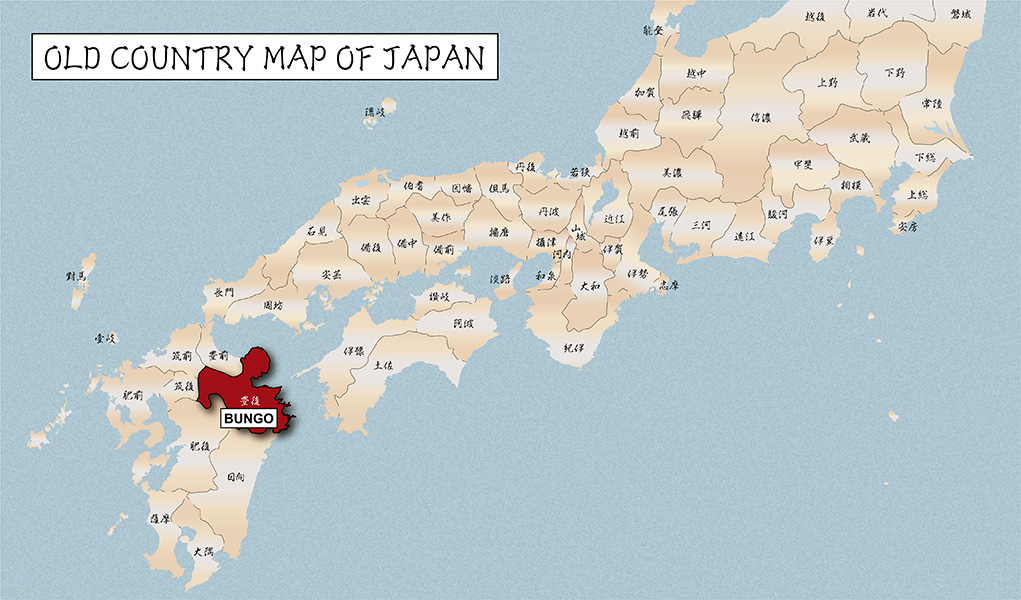
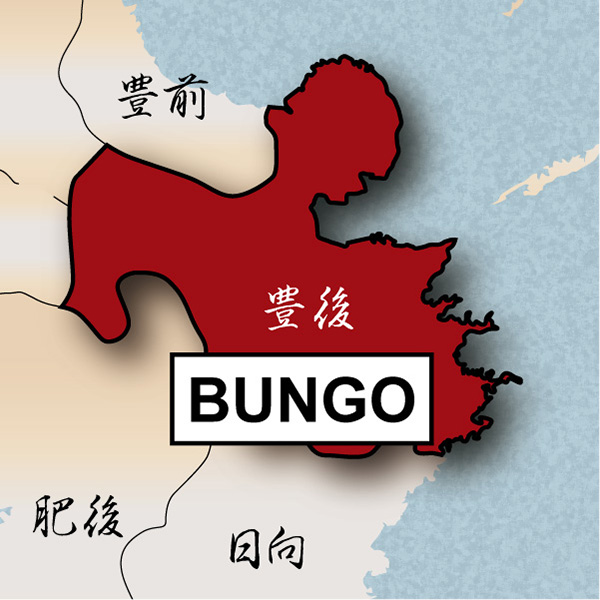
During Sengoku Period (the warring state period: from late 15 C to late 16 C), the Takada school forged many swords for many Samurais in Kyushu island. It is said that the reputation of the blades forged by Takada school was close to MINO or BIZEN swords, two of which are the most famous sword forging places.
The Bungo domain was ruled by Otomo Yoshishige (Sorin) during the Sengoku period. Yoshishige and his domain built a strong military and political base there. Yoshishige was known as one of the most famous warlords on Kyushu island. It is said that Takada swordsmiths forged swords for those who served the Otomo clan.
Generally speaking, Kyushu island was prosperous in sword-making because of its long trading history with Asian countries. Many feudal lords on this island fought against each other to gain an advantage in trading. Takada school received many orders as the demand increased among those lords.
The material of Japanese swords(high-quality iron sand and charcoal) was abundant in mount Sobo Katamuki, located near Takada village. We believe Takada school prospered because of its geographic location and natural resources.
*Please keep in mind that there are a couple of kitae Kizu on the Mune (backbone of the blade). You will also find a minor Kitazu on the edge part. If you like to know the detailed condition, please feel free to contact us.
What is Daisho?
Daisho is a pair of two Japanese swords Samurai carried. During the Edo period, having Daisho in public places was considered social status for Samurai. Furthermore, Samurai were required to wear them under the law back then. Daisho is written as 大=Big and 小=Small. Dai part means Katana, and Sho part means Wakizashi. We are confident you would find this pair of Daisho gorgeous. They have such a fancy appearance that we believe a high-ranked Samurai owned them.
Appraisal
This Katana blade is appraised as a Tokubetsu Hozon Token(特別保存刀剣) and this Wakizashi is appraised as a Hozon Token (保存刀剣). They were issued by NBTHK(Nihon Bijutsu Touken Hozon Kyokai:日本美術刀剣保存協会). These authentication papers were only given to authentic Japanese swords well preserved and high quality with artistic value.
【 Blade】
Katana
Cutting Edge Length(Nagasa):70.0 cm ( 27.5 inches)
Curvature(Sori):0.70 cm (0.27 inches)

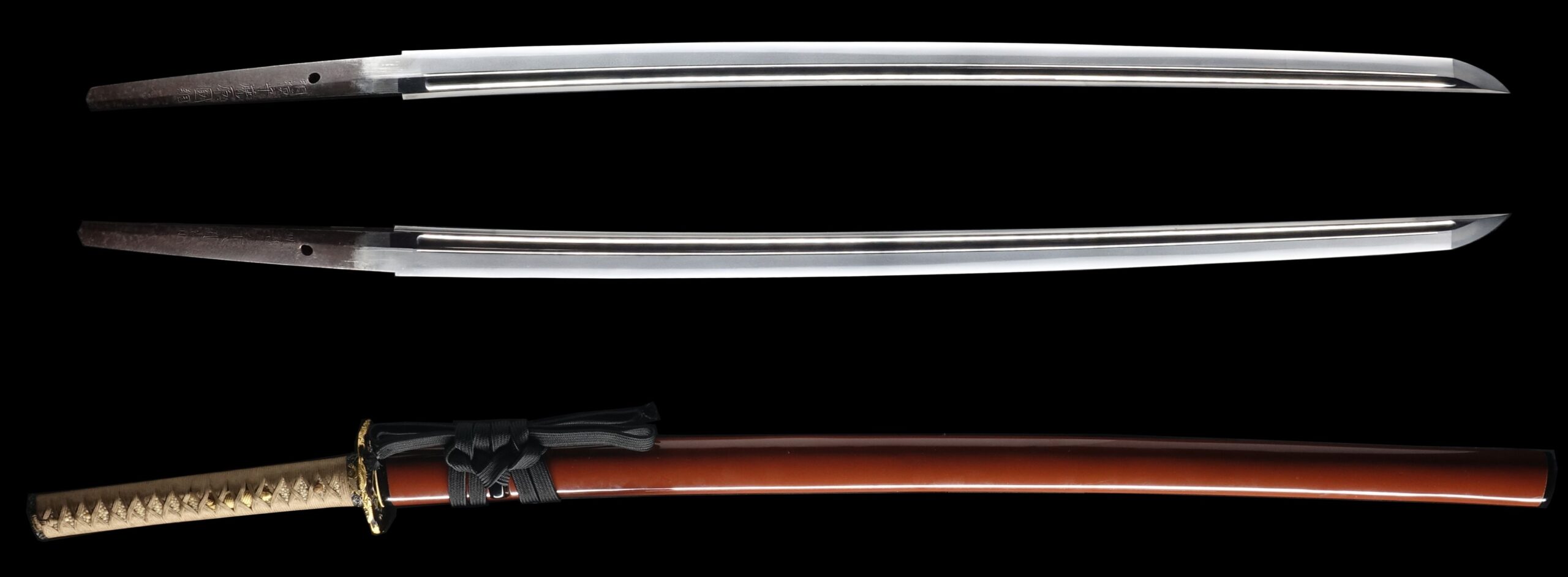
Wakizashi
Cutting Edge Length(Nagasa):54.6 cm ( 21.5 inches)
Curvature(Sori):1.21 cm (0.47 inches)

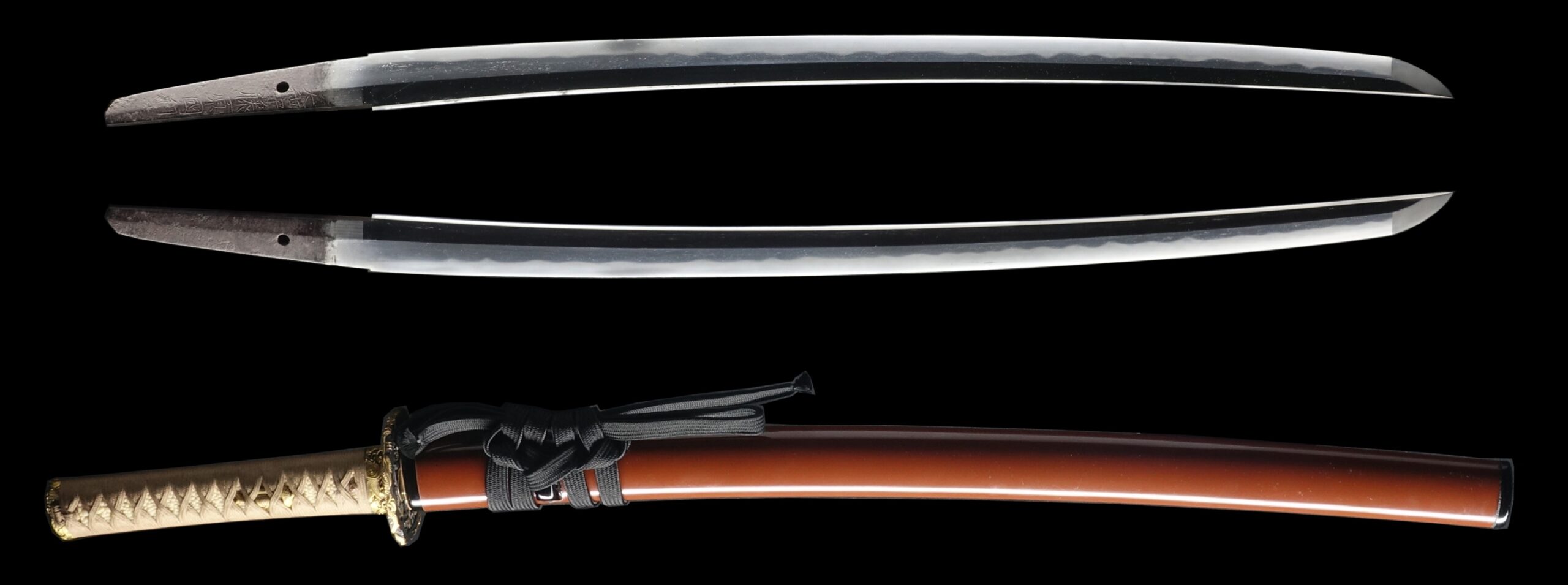
Katana
Hamon:
The crystalline structure which forms along the cutting edge of a blade as a result of the hardening process
Jimon(Jihada):
visible steel surface pattern created by folding and hammering during forging process
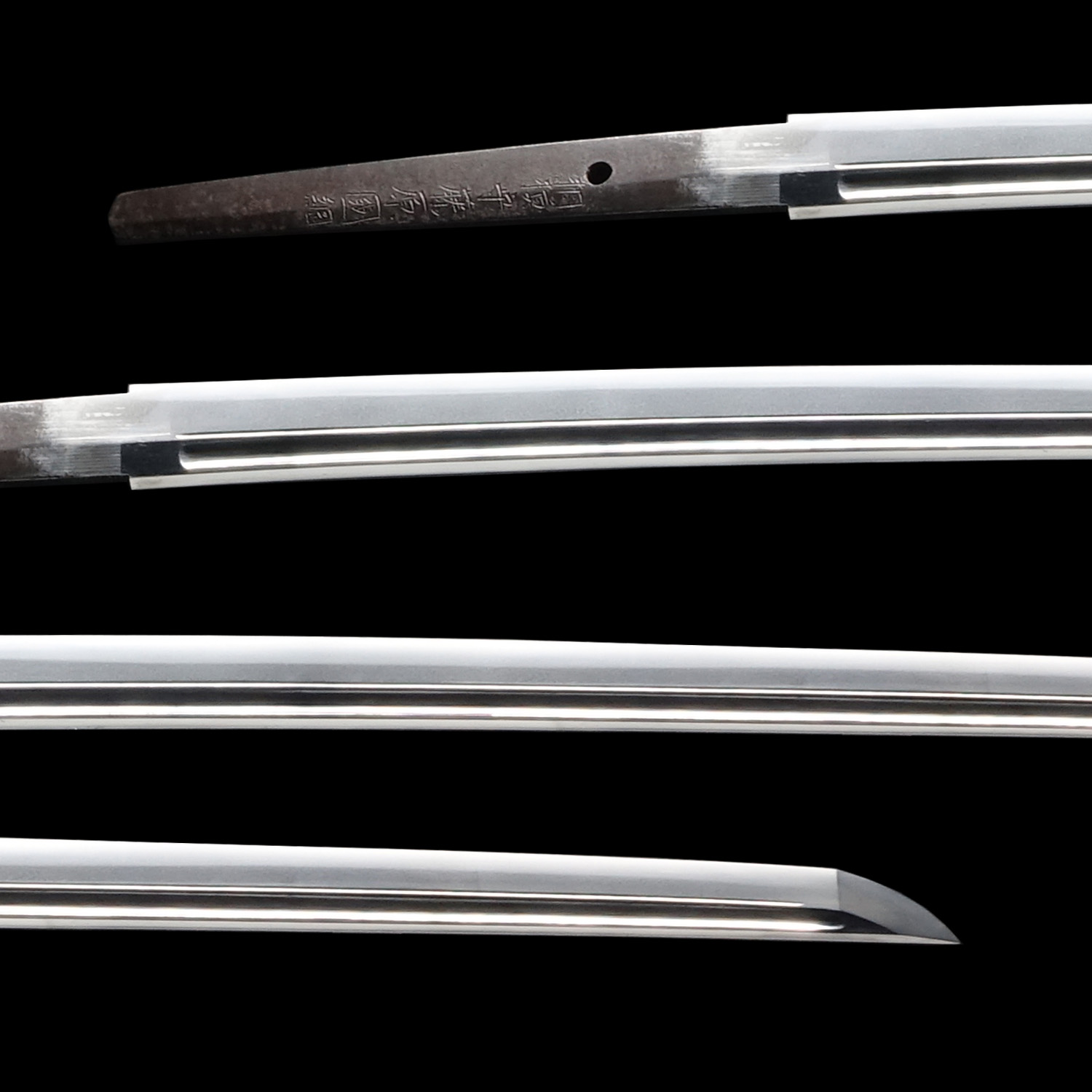
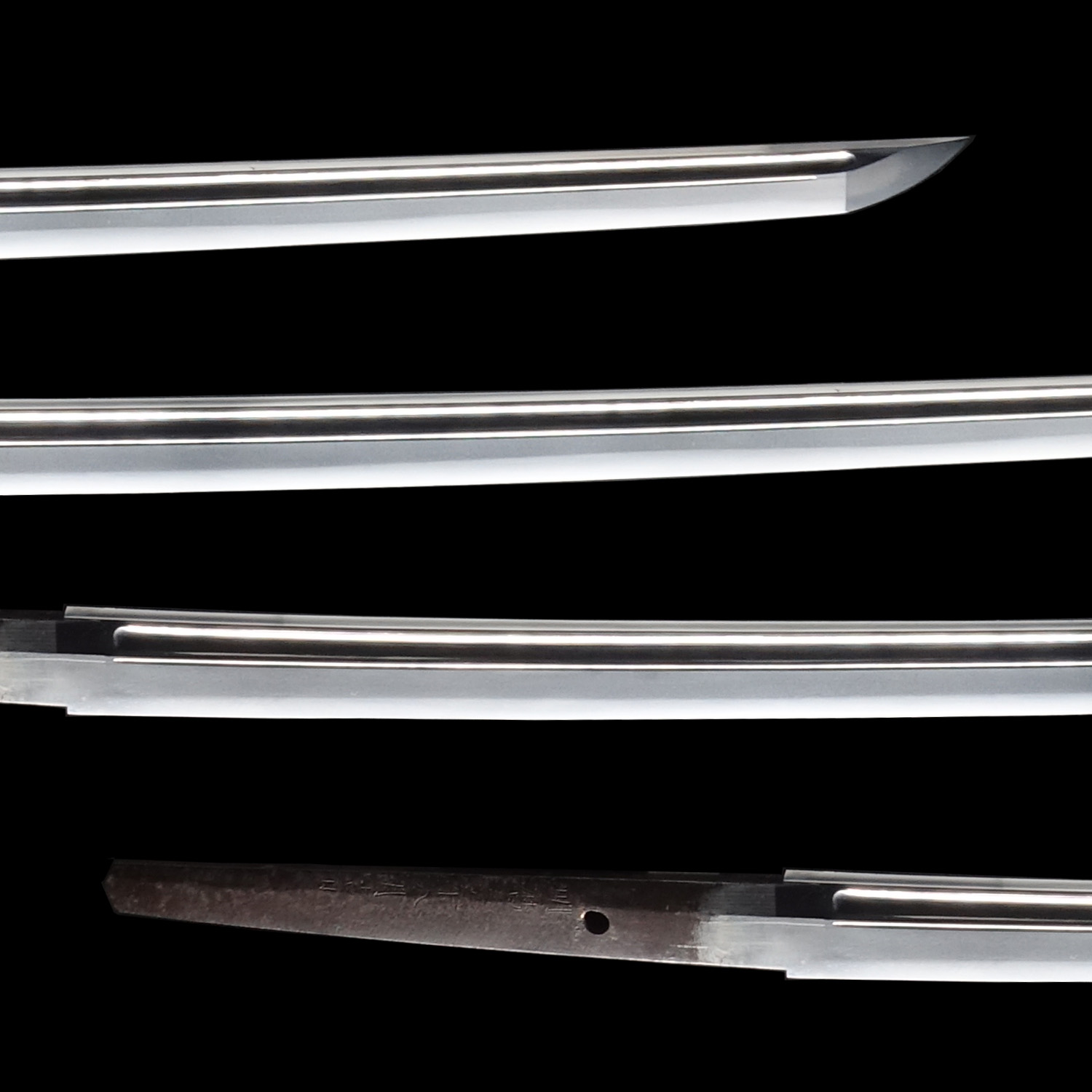
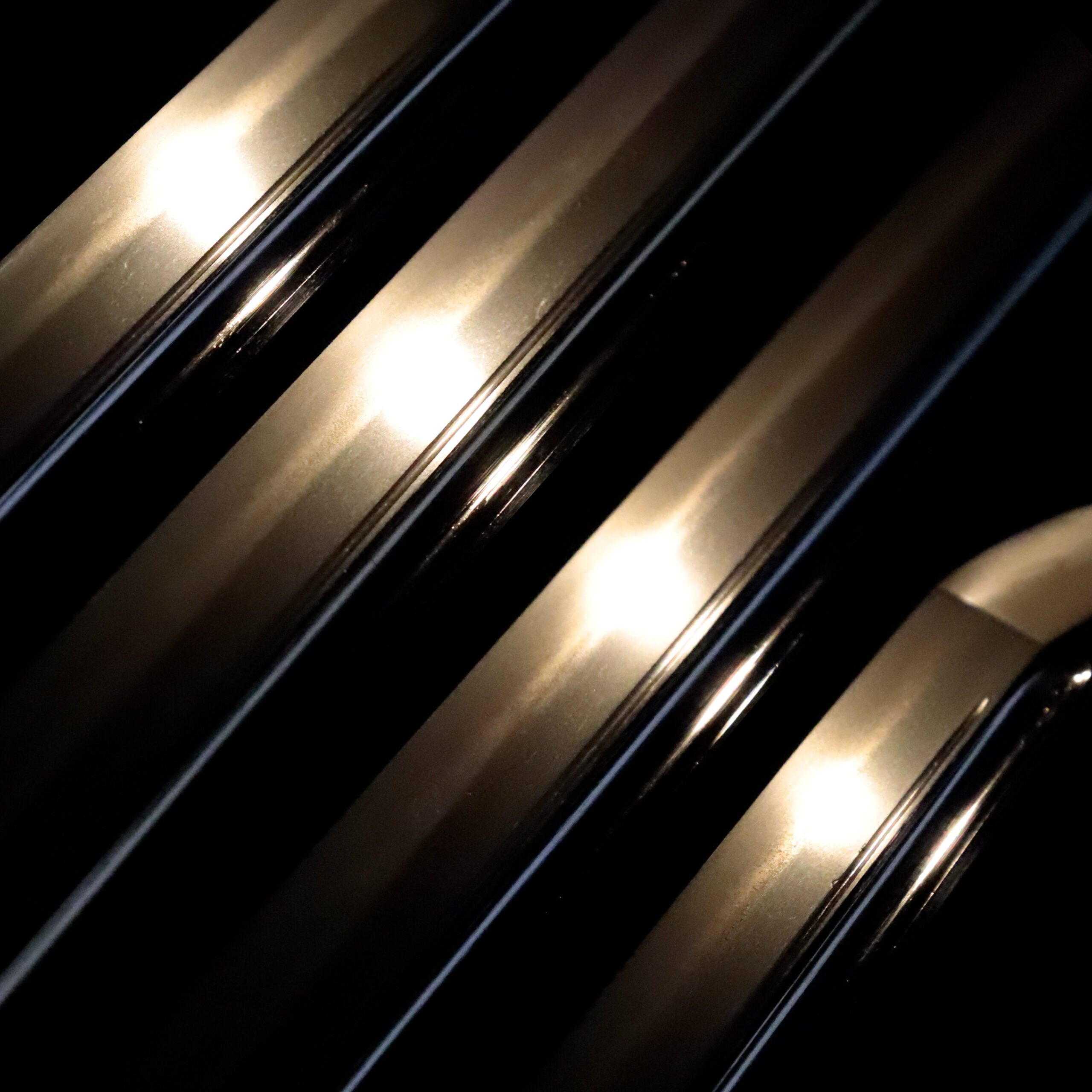
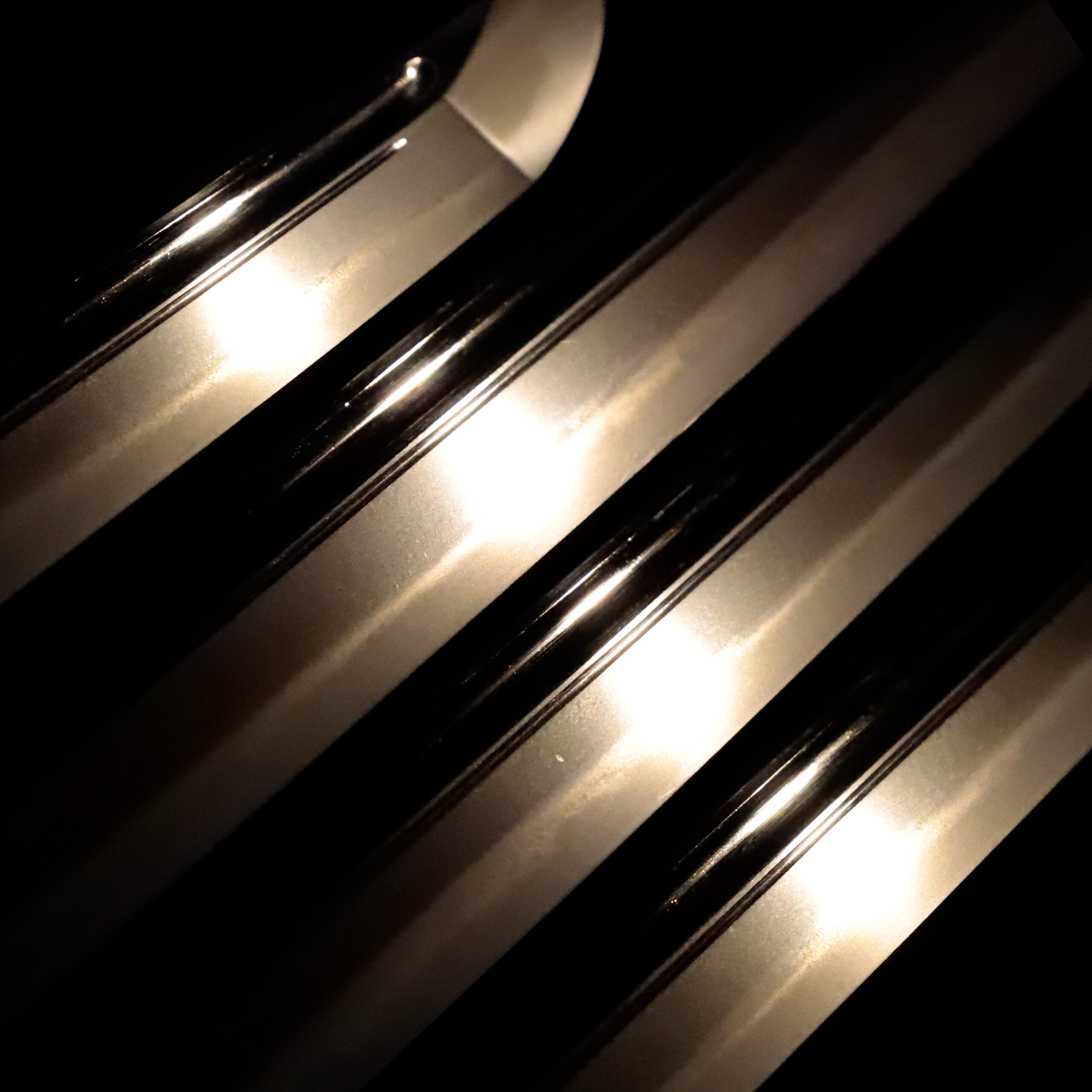
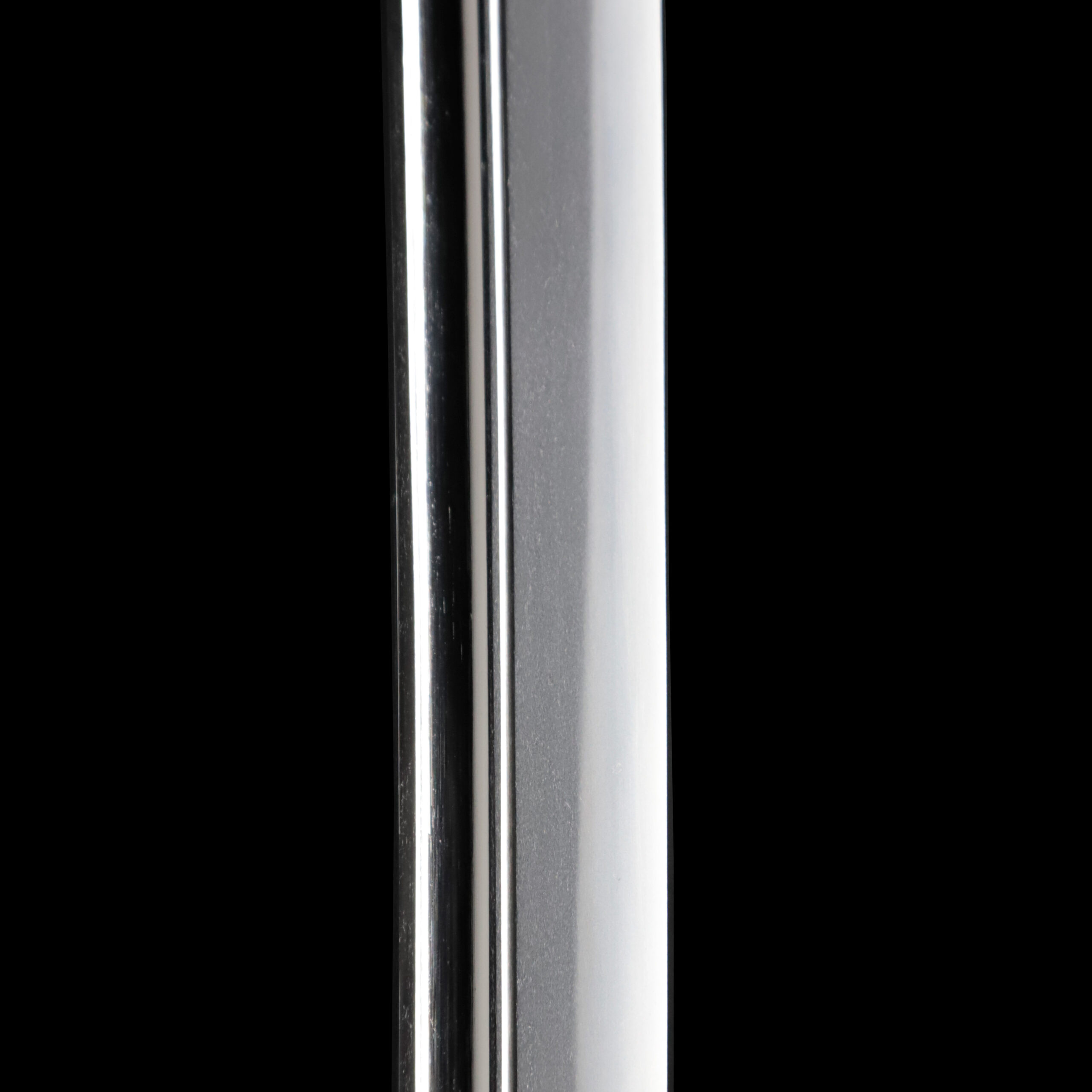
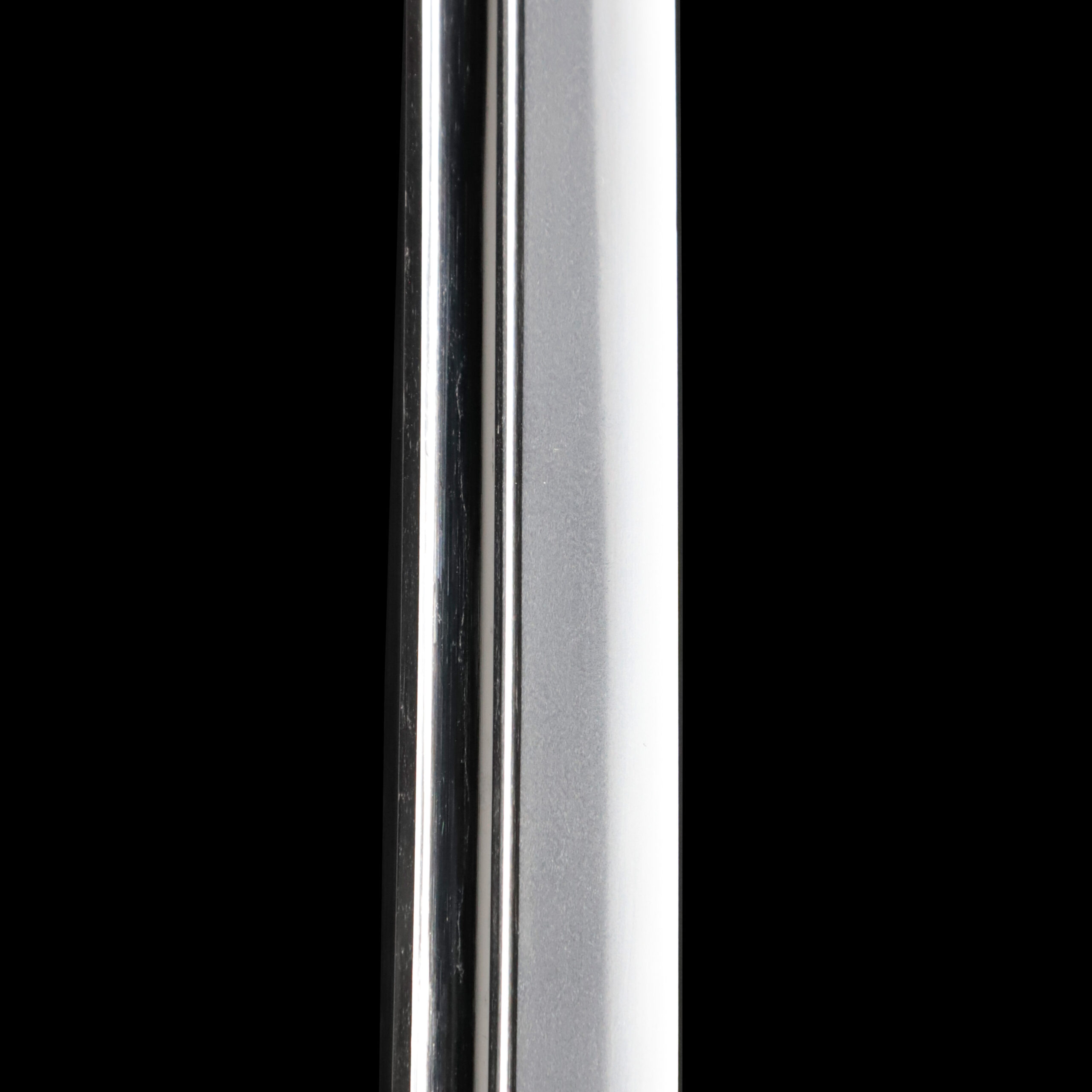
Wakizashi
Hamon:
The crystalline structure which forms along the cutting edge of a blade as a result of the hardening process
Jimon(Jihada):
visible steel surface pattern created by folding and hammering during forging process

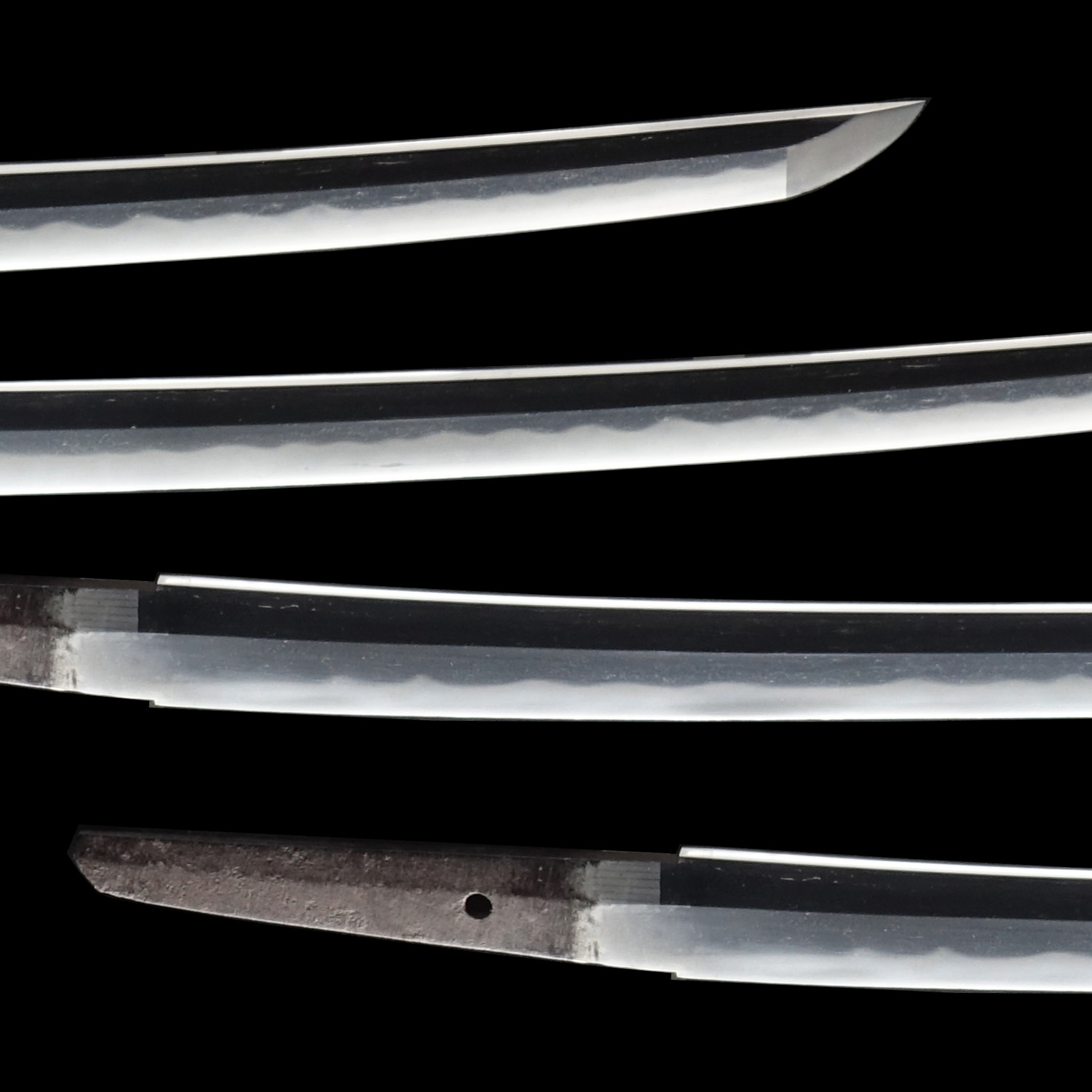

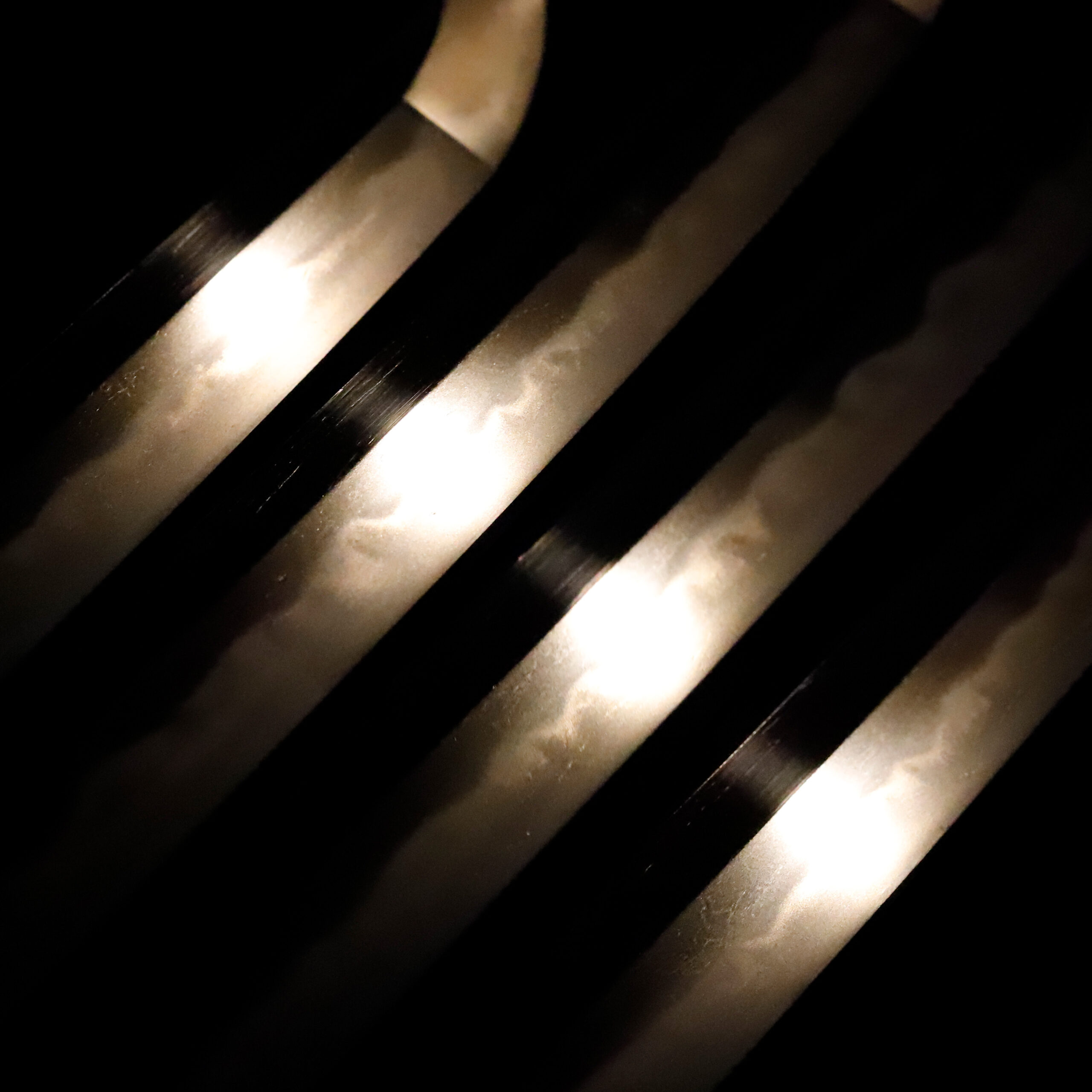

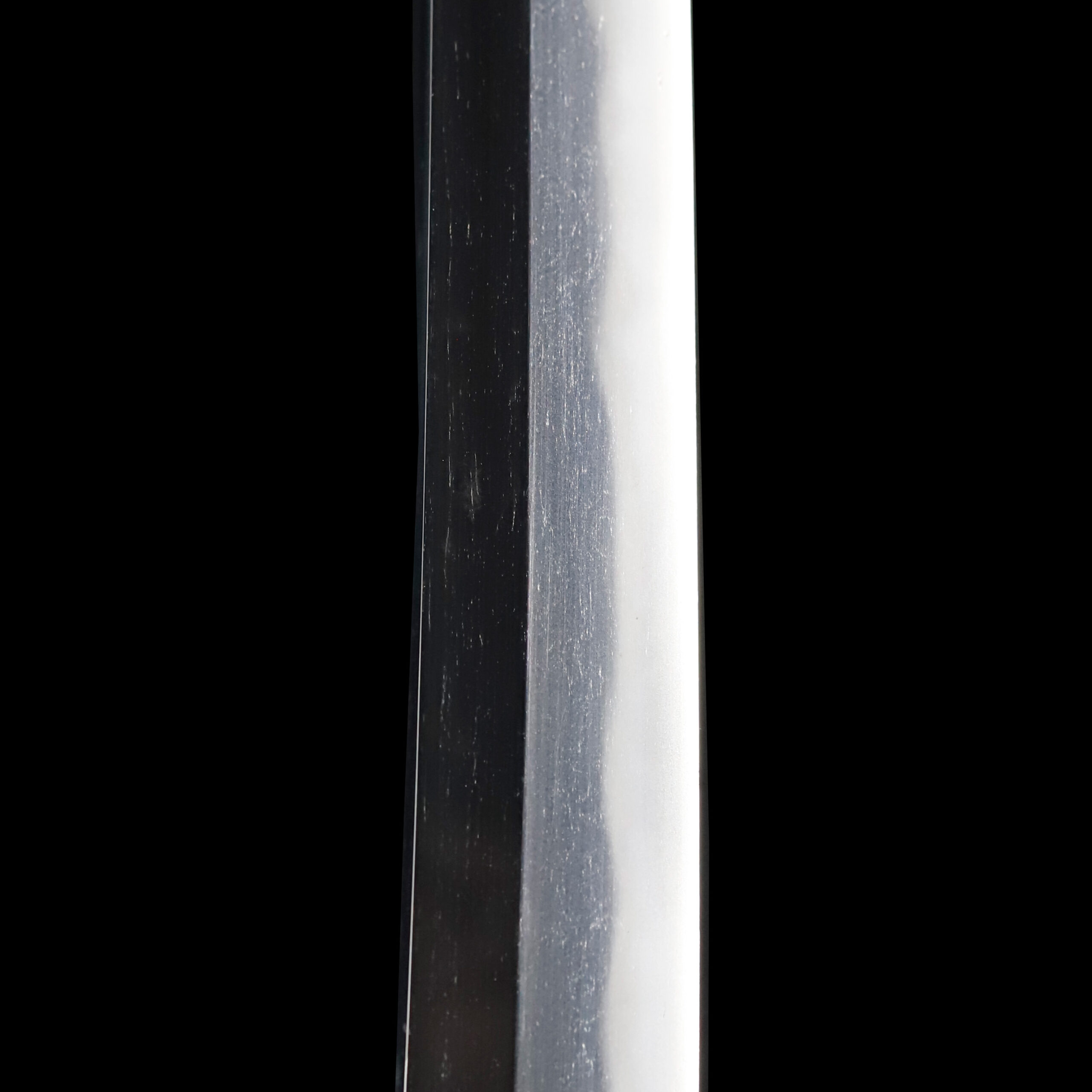
Nakago:Nakago is the tang of the Japanese sword.
Japanese swordsmiths left the black rust on the tang on purpose to prevent red rust while the tang is in its handle. And the discoloration of the tang was created over time, which is a great indicator for a Japanese sword specialist to estimate when the sword was forged.
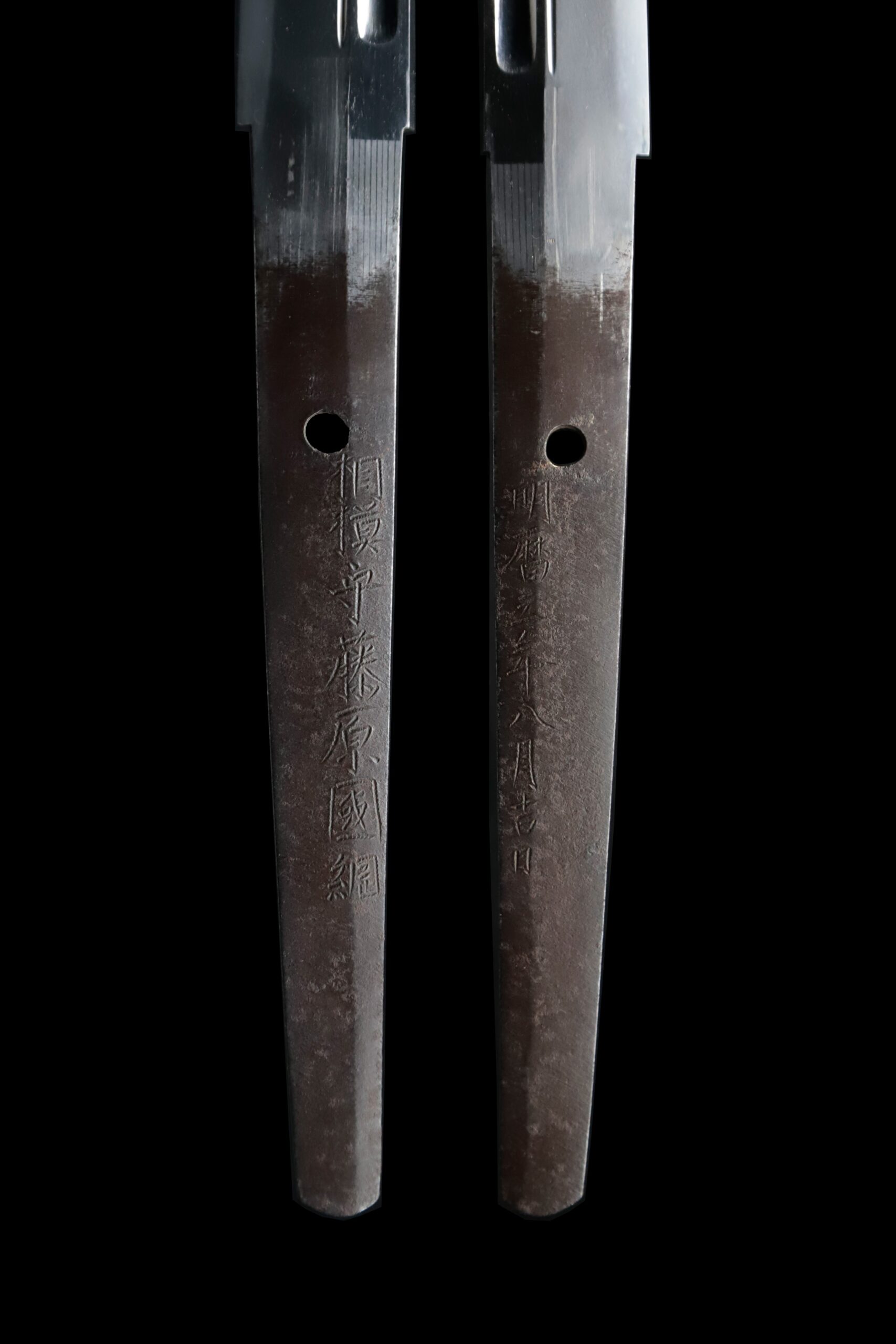
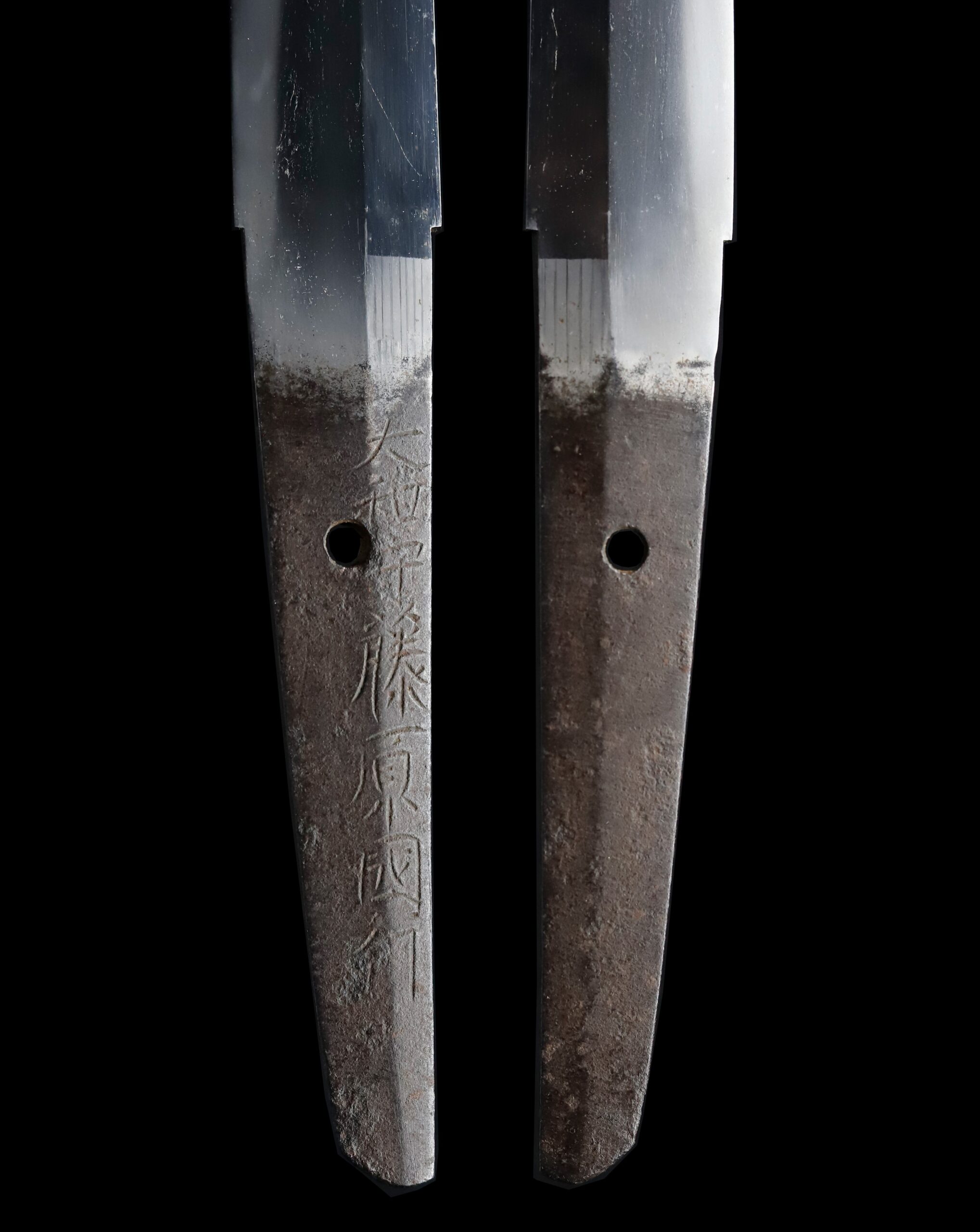
Koshirae: Koshirae is the mounting of the Japanese sword. There are several parts that consist of Koshirae such as Saya(Scabbard), Tsuka( Handle), Tsuba(Handguard).
The common motif of this Daisho Koshirae is the Koi (鯉, domestic carp). You would find this fish design on the Fuchi Kashira, Menuki, and Kozuka. Based on an ancient foreign story, many fish tried to climb the waterfall called the Ryumon (竜門, dragon gate) in the rapid stream of the Yellow River. As a result, only Koi climbed up and became a dragon and ran through the sky. It is the reason why “Koi-no Taki Nobori” (鯉の滝昇り, domestic carp climbing waterfall) became a symbol of success in life. The Ryumon legend is associated with this story. By living confidently and making efforts, people hoped for their children to grow up to become magnificent people. Samurai families back then might have used this fish motif, wishing their sons to be promoted to high-ranked Samurai.
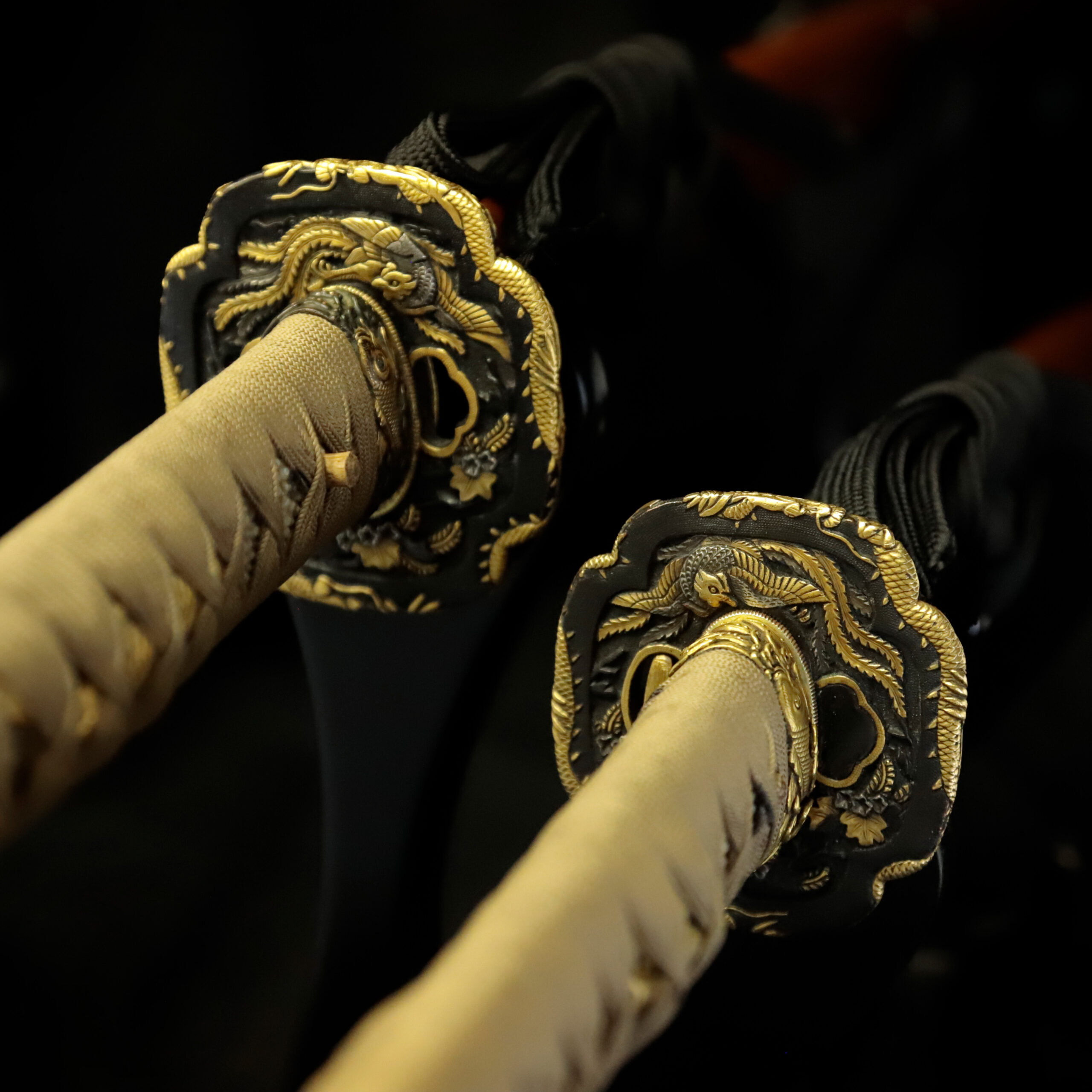
Fuchi-Kashira:A pair of matching sword fittings that cover the upper and bottom parts of its sword hilt.
We estimate this Fuchi Kashira’s design might expresses a scenery in the legend of Koi-no Taki Nobori (for getting the detail of this tradition, please check the description above about the Koshirae). The semi three dimensionally sculpture depicts carps swimming in the rough waves, creating a vibrant work of art. If you look at the side of the Fuchi Kashira, you would find a Mei (銘, engraved inscription). It is written as follows: 大森 英秀 (Ōmori Teruhide), and his stylized signature. According to a record, there was a metalworker whose name was Ōmori Teruhide (1730-1798), who did well in the middle of the Edo period. He was adopted by Ōmori Hidemasa, a disciple of Yokoya Sōmin, and later inherited the headship of the family. He was the person who devised carving techniques such as wave drawing called the Ōmori Nami (大森波) and the Kin Nashi-ji Zougan (金梨地象嵌, a type of gold inlay). However, please note that there is no proof of authenticity about this engraved signature. We introduced him to you only as a possibility.
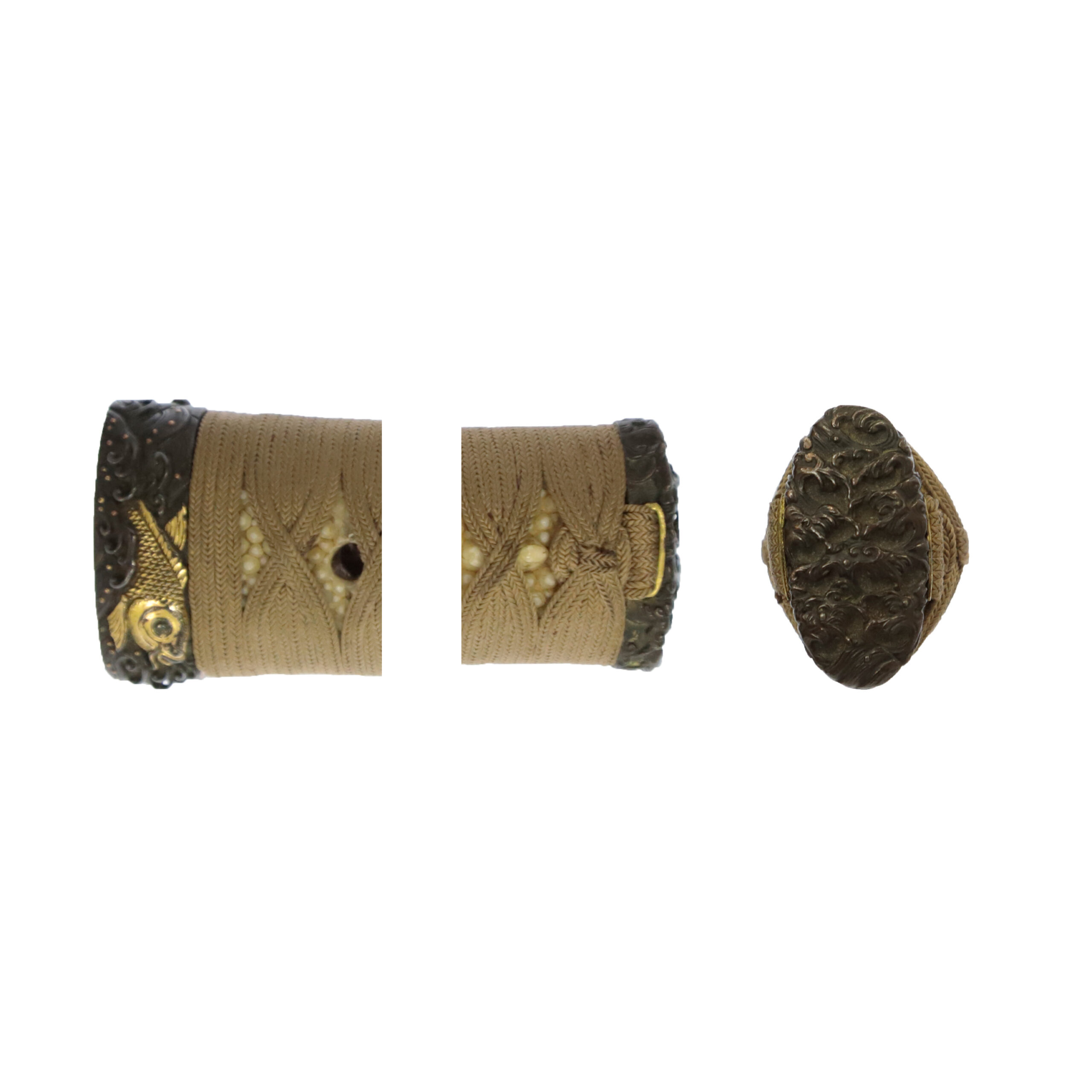
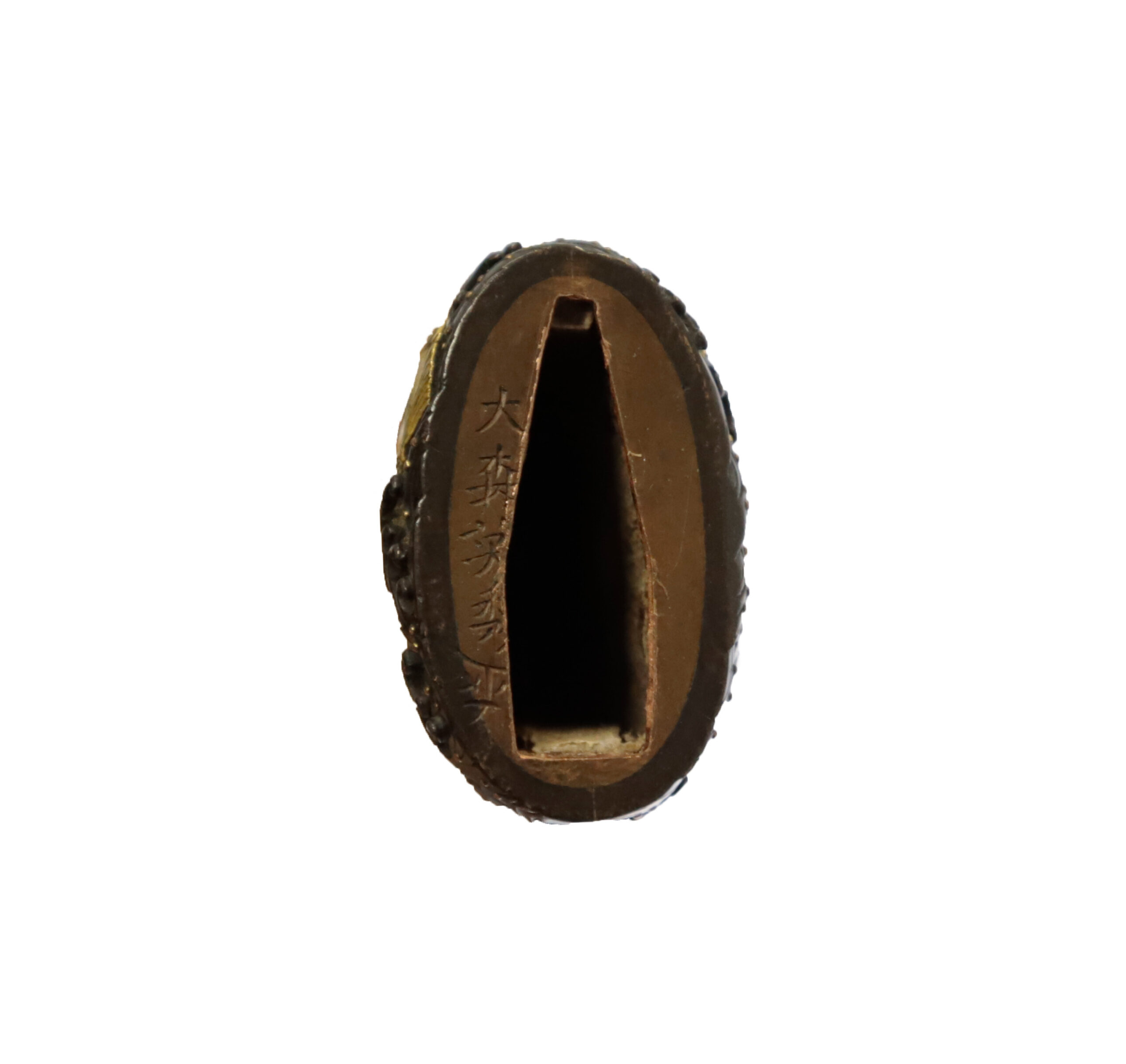

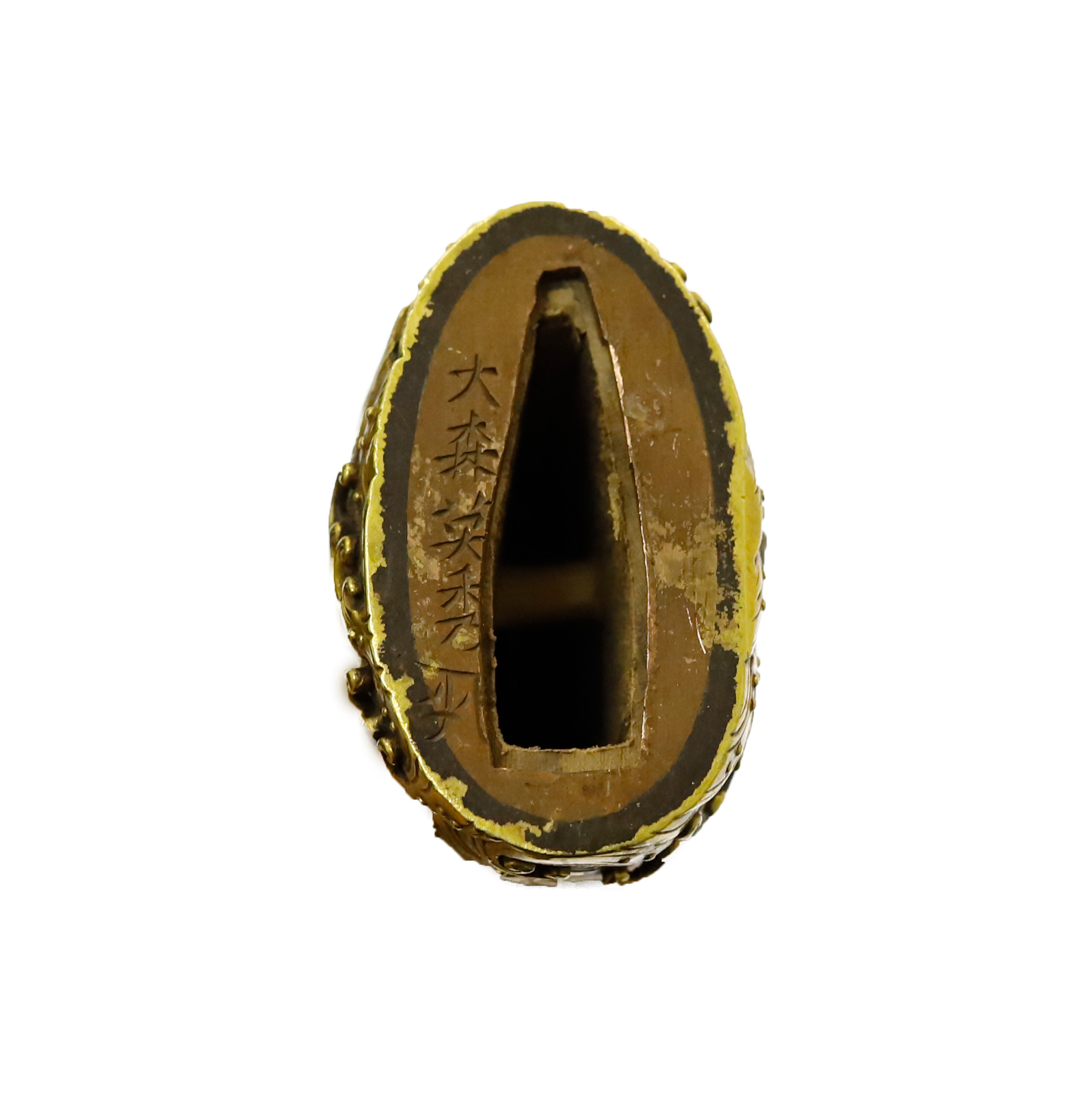
Tsuka and Menuki:Tsuka is the handle of the Japanese sword and Menuki is its decoration.
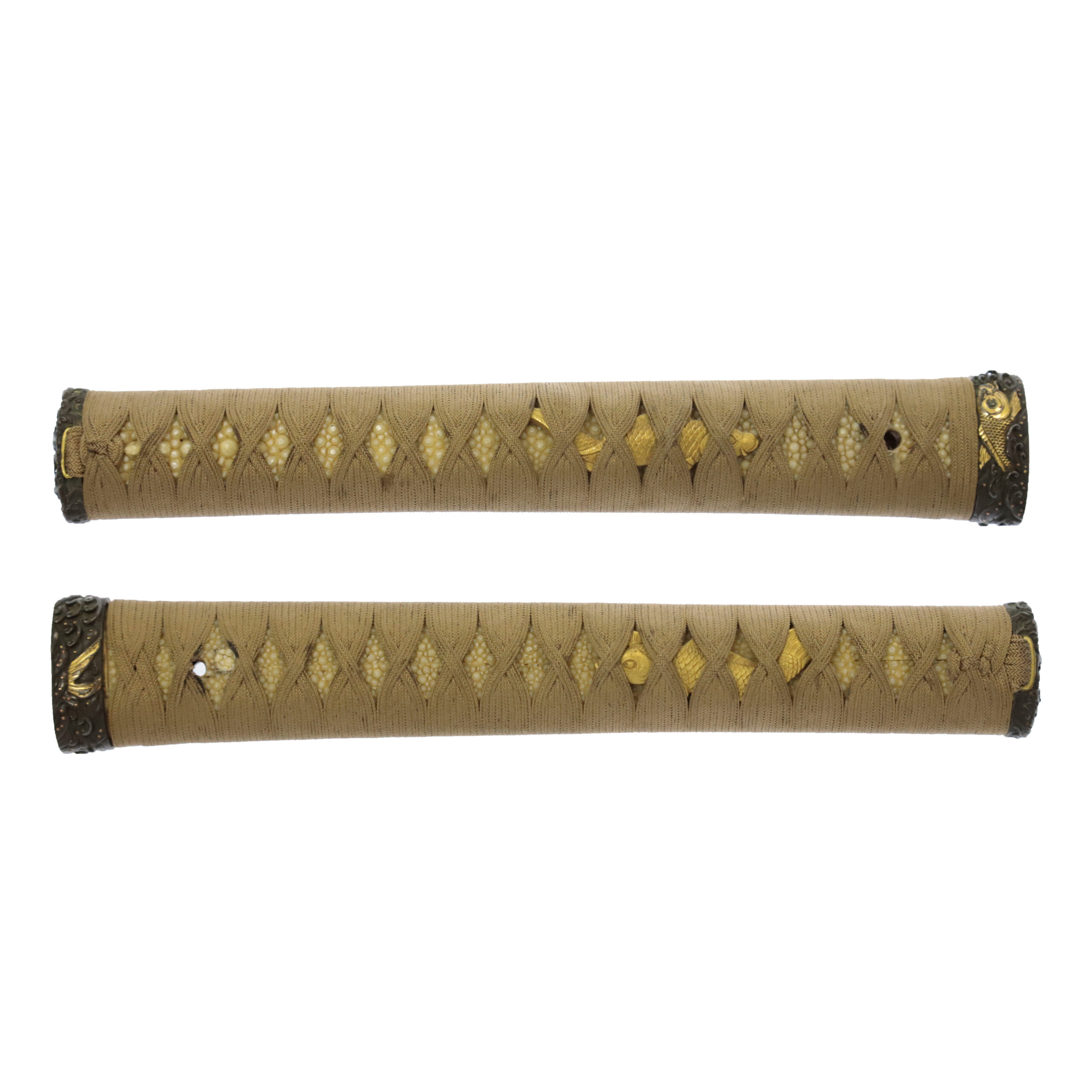

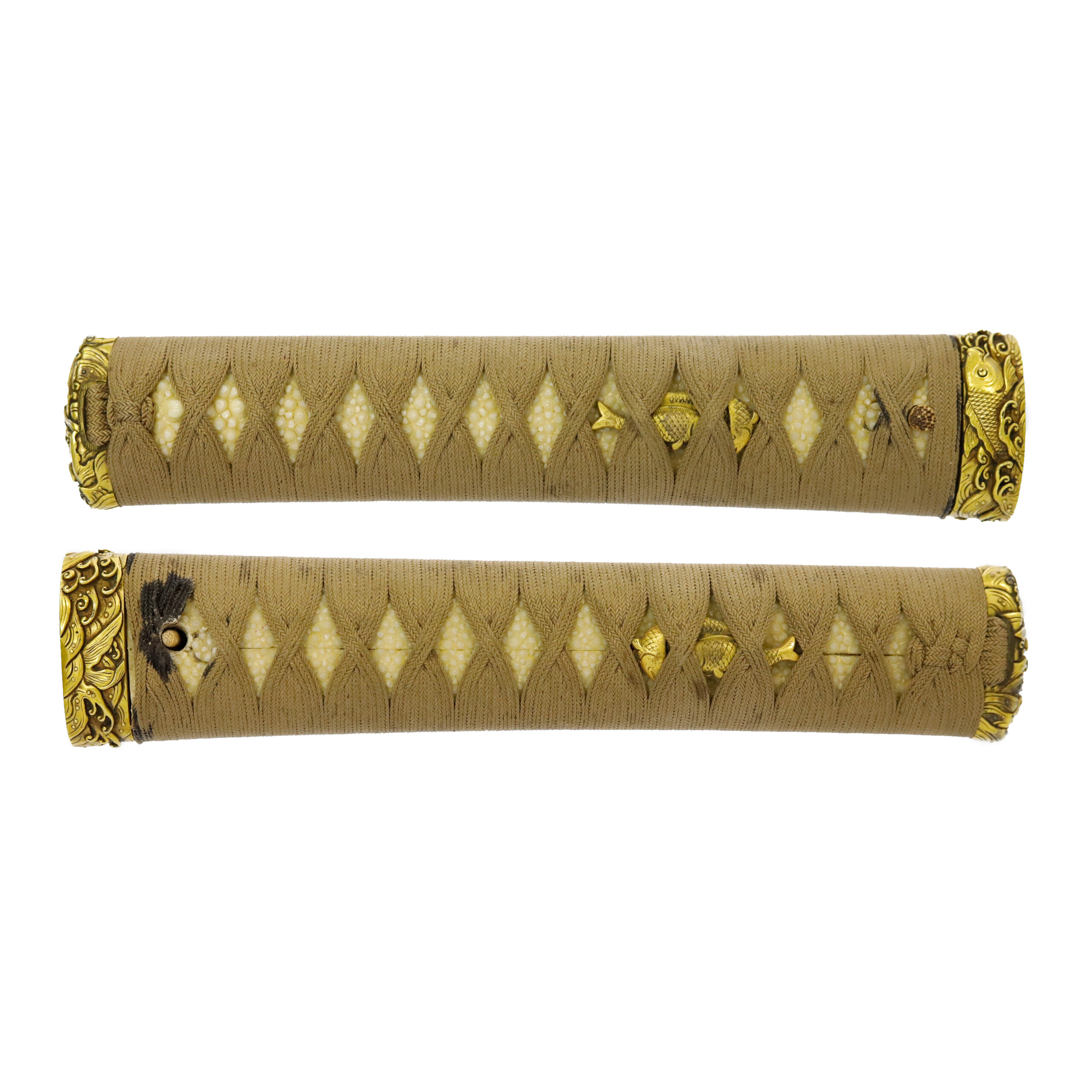
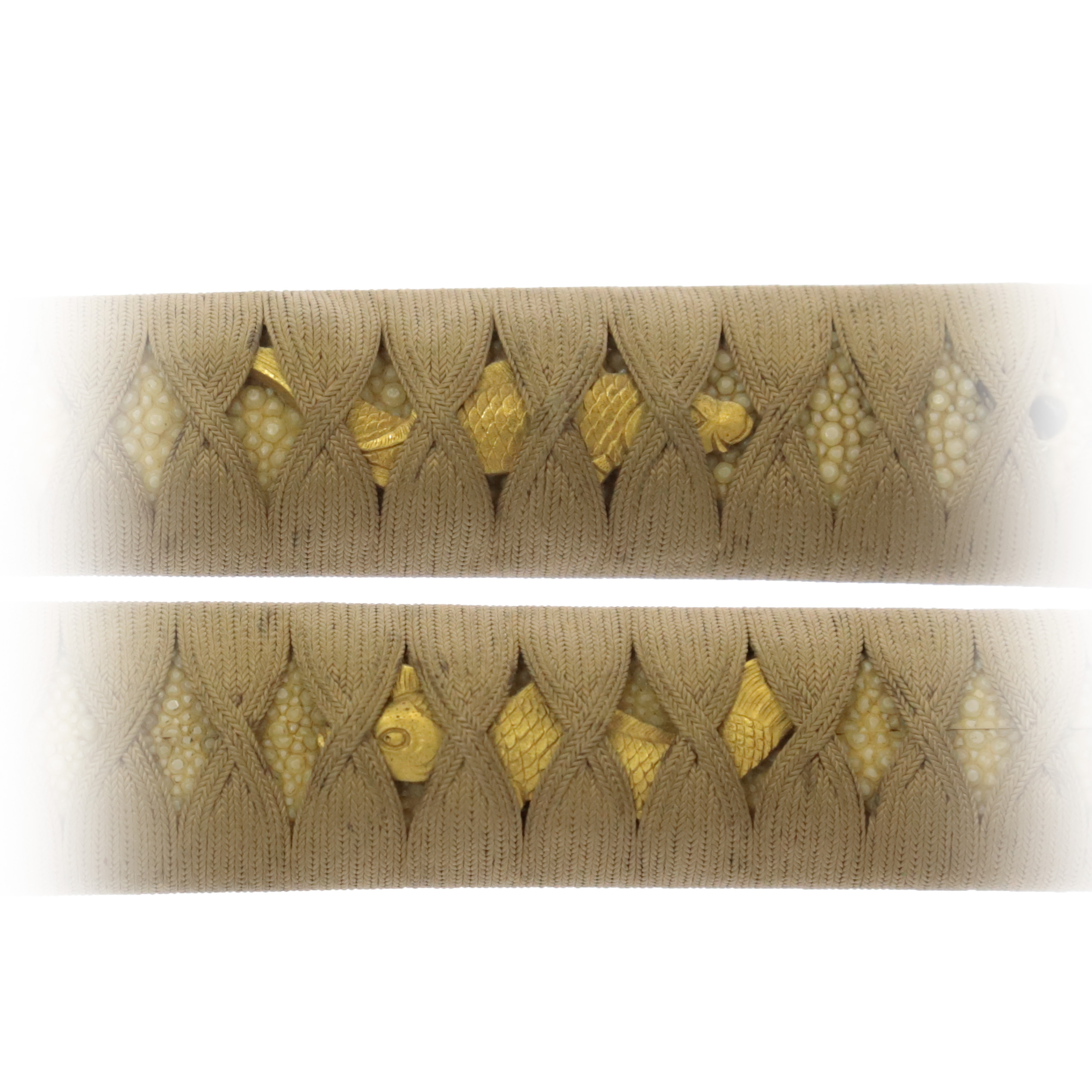
Tsuba and Habaki:Tsuba is the handguard for the Japanese Sword and Habaki is the equipment to make the blade not touch its scabbard inside. It prevents the blade from getting rusty and chipped.
This Tsuba is the only part with an entirely different design among the sword mountings of this Koshirae. We think it is the bird that you would probably notice at first. We believe this bird is the Houou (鳳凰, Fenghuang). The Houou is a member of four fantasy animals, which is called the Shirei (四霊) with Kirin (麒麟, Qilin), Kame (亀, Turtle), and Ryu (龍, Dragon), and it is a god beast looks like a combination of chicken and peacock. This sacred bird was considered an auspicious sign in the continent, and it was believed that the Houou would show up when the brilliant emperor appeared. People appreciate its graceful shape in Japan.
The plant motifs designed on this Tsuba are the Kiri (桐, paulownia) flowers. This plant pattern has been used in many family crests, and the number of blooming flowers at each inflorescence means the ranks of this design. According to tradition, the Houou rests its wings at paulownia trees. Therefore, it has come to be regarded as a holy plant.
At the edge of this Tsuba, you would find that dragons wrap their bodies around it. The combination of dragon and Houou is treated as a very auspicious motif. Dragons have been thought to reign at the top of all animals because of their odd-looking appearance. The Houou is said to bring lasting prosperity and is revered as a lucky charm that prays for health, longevity, and the wealth of countries and organizations. In addition, it is believed that the happiness a dragon brings would last for a long time by displaying Houou as a pair of a dragon. Also, we remember the legend of the Koi-no Taki Nobori. It is likely that the dragons were incorporated into this Tsuba due to its relationship with the Houou. However, considering the folklore about carp, we were able to find commonalities here with the designs of other sword mountings.


Kozuka:Kozuka is a small knife stored in Kozuka Hitsu(groove of the sheath of the Japanese sword).
A Kogatana (小刀, small knife) is stored in the Kozuka. The surface of this Kozuka is decorated with the Nanako-Ji (魚子地) technique. This process makes a uniform minimal protrusions pattern by hitting the Nanako-Ji Tagane (魚子地鏨, a chisel for this technique) on a metal surface. This decorative technique is often seen on sword mountings. The same as other sword mountings, such as the Fuchi Kashira and Menuki, domestic carps are designed on this Kozuka. The presence of several aquatic plants floating around the carps suggests that it depicts the underwater situation.
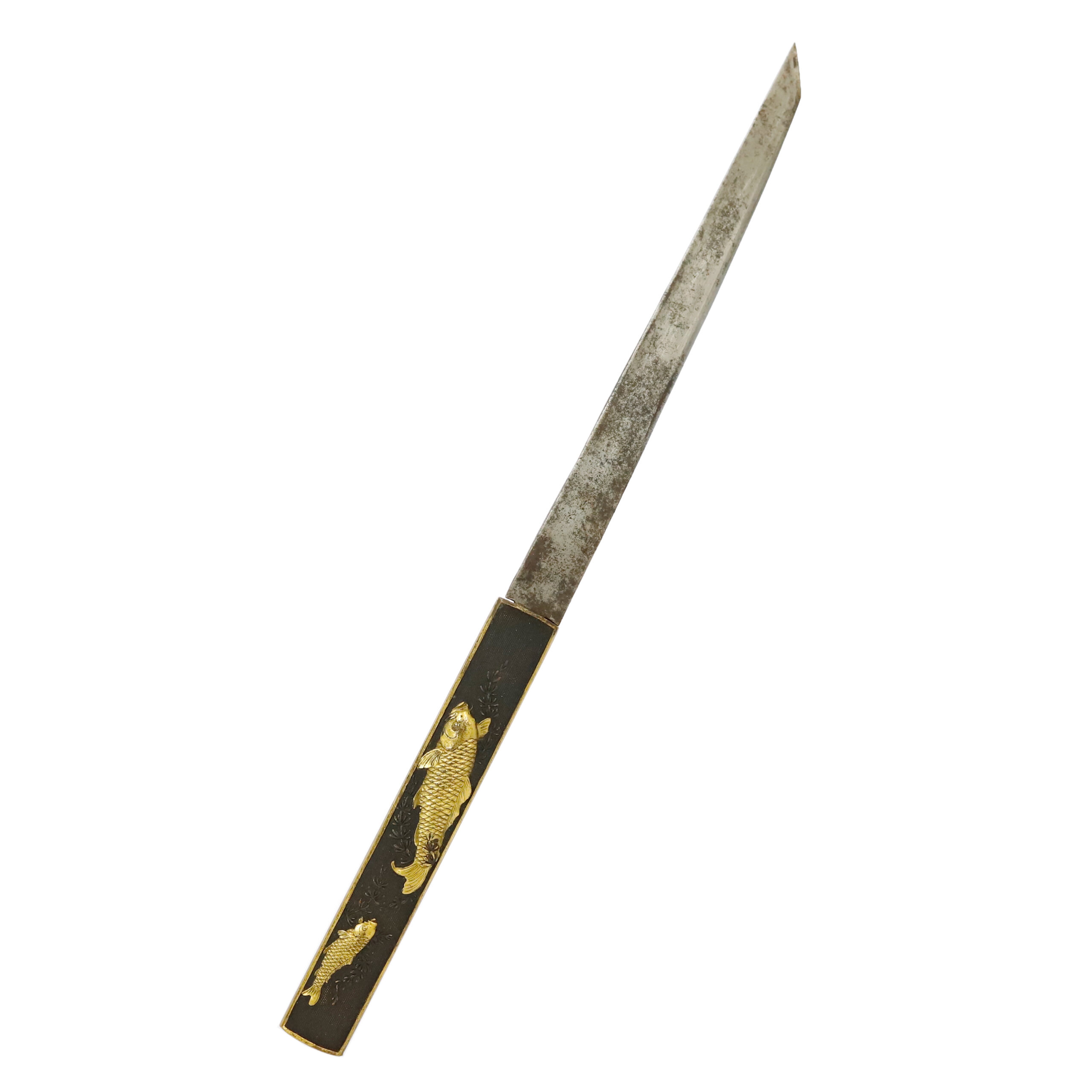
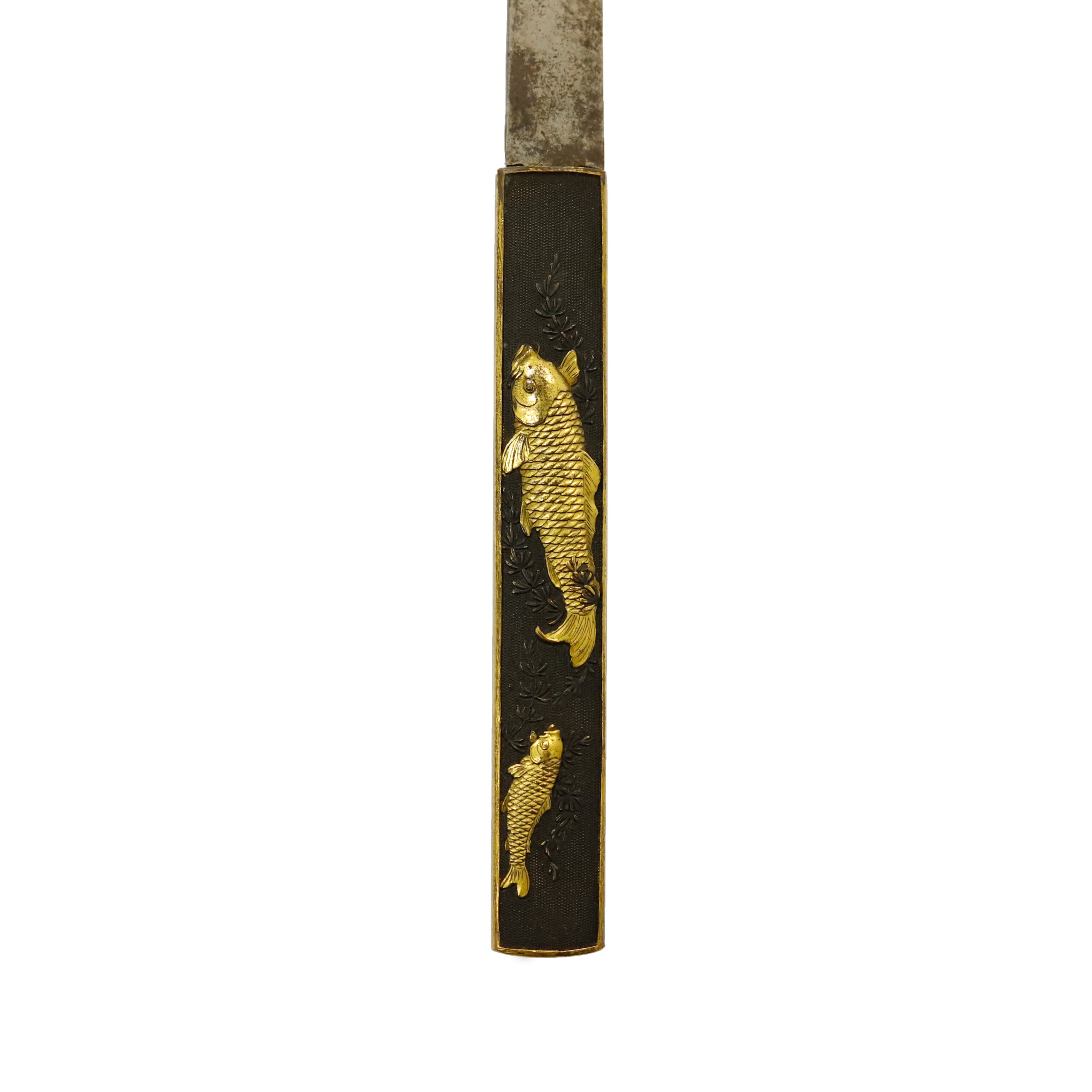
Saya: Saya is the scabbard for the Japanese sword.
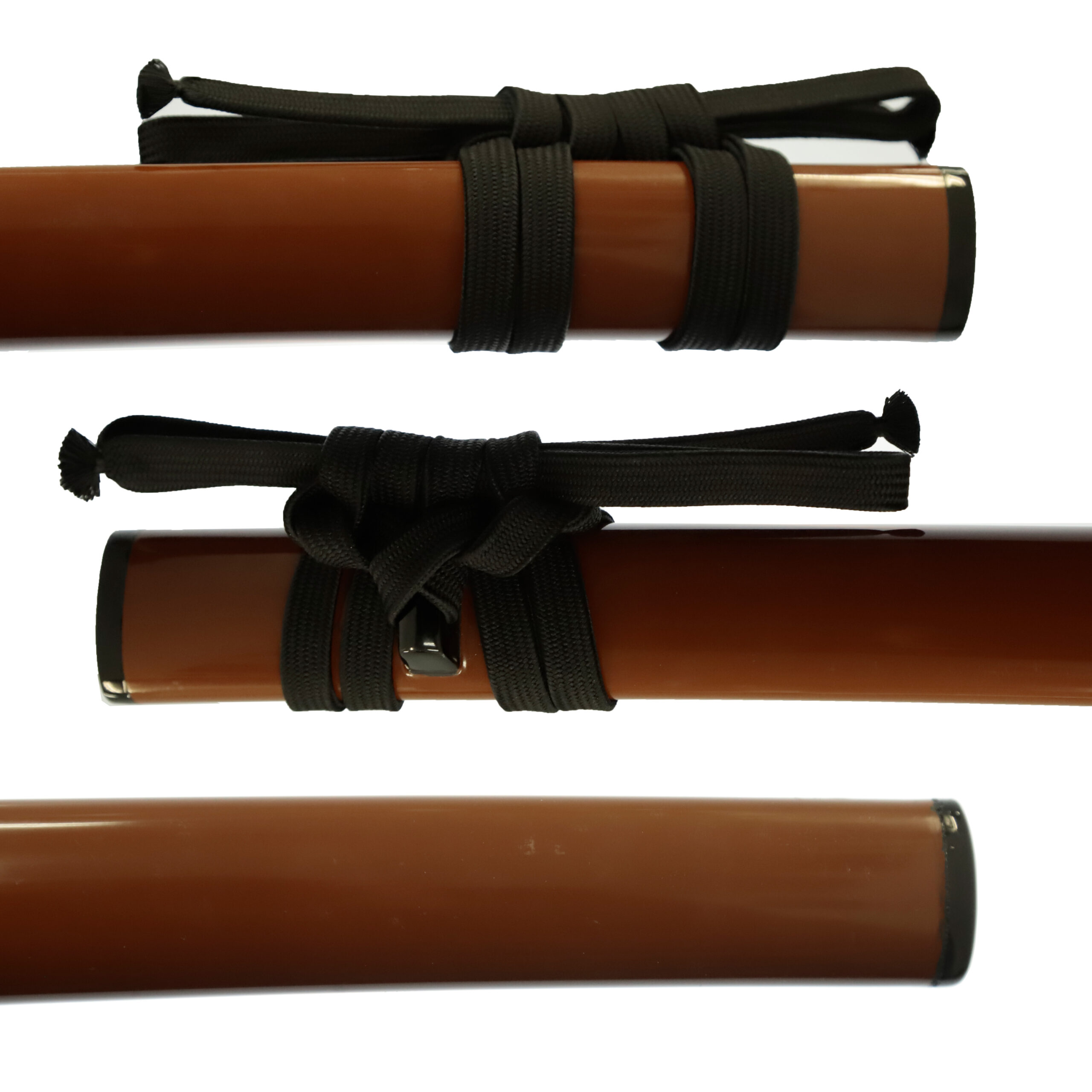
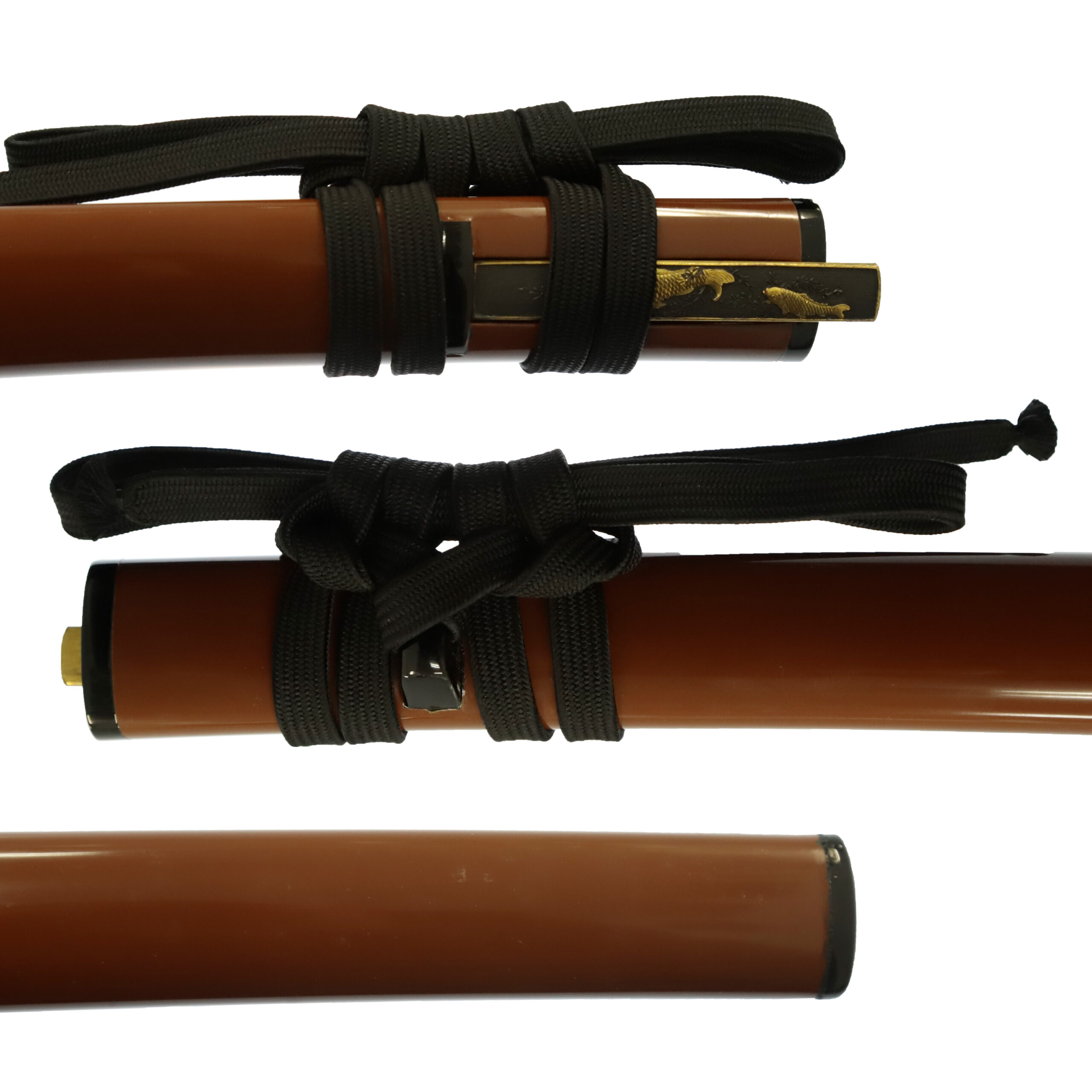
Authentication Paper:NBTHK Tokubetsu Hozon Certificate for the blade (No. 1006775)and NBTHK Hozon Certificate for the Wakizashi (No. 3031639)
NBTHK,, also known as Nihon Bijutsu Touken Hozon Kyokai (the Society for the Preservation of the Japan Art Sword), is one of the oldest Japanese sword appraising organizations in modern-day Japan. They authenticated the Katana blade on Feb 2nd in the 29th year of the Heisei era (2017) and Wakizashi on May 31th in the 5th year of Reiwa (2023). They appraised the Katana blade as Tokubetsu Hozon Touken and Wakizashi as Hozon Token, blades worth preserving for Japanese society. The purchaser will receive these original certificates as well. We can also translate what is written into English and make a PDF file for your record if you request.


Registration Number : Tokyo 23313-Oita 4192
The Board of Education in Tokyo issued a registration paper for the Katana blade and Oita prefecture issued a registration paper for the Wakizashi sword . It is called Jyu Token Rui Torokusho(銃刀剣類登録証). Bunkacho(The Agency for Cultural Affairs) acknowledges a Japanese sword with this paper as a work of art.
The sword needs to be traditionally hand-forged and made of Tamahagane carbon steel to be registered in the system. With this paper, its owner in Japan can legally own an authentic Japanese sword. Based on this registration number, we will apply for its export permit.
This paper will need to be returned to the board of education when the sword is being shipped abroad, but you can receive a copy of it. An English translation of this registration paper is available on request.
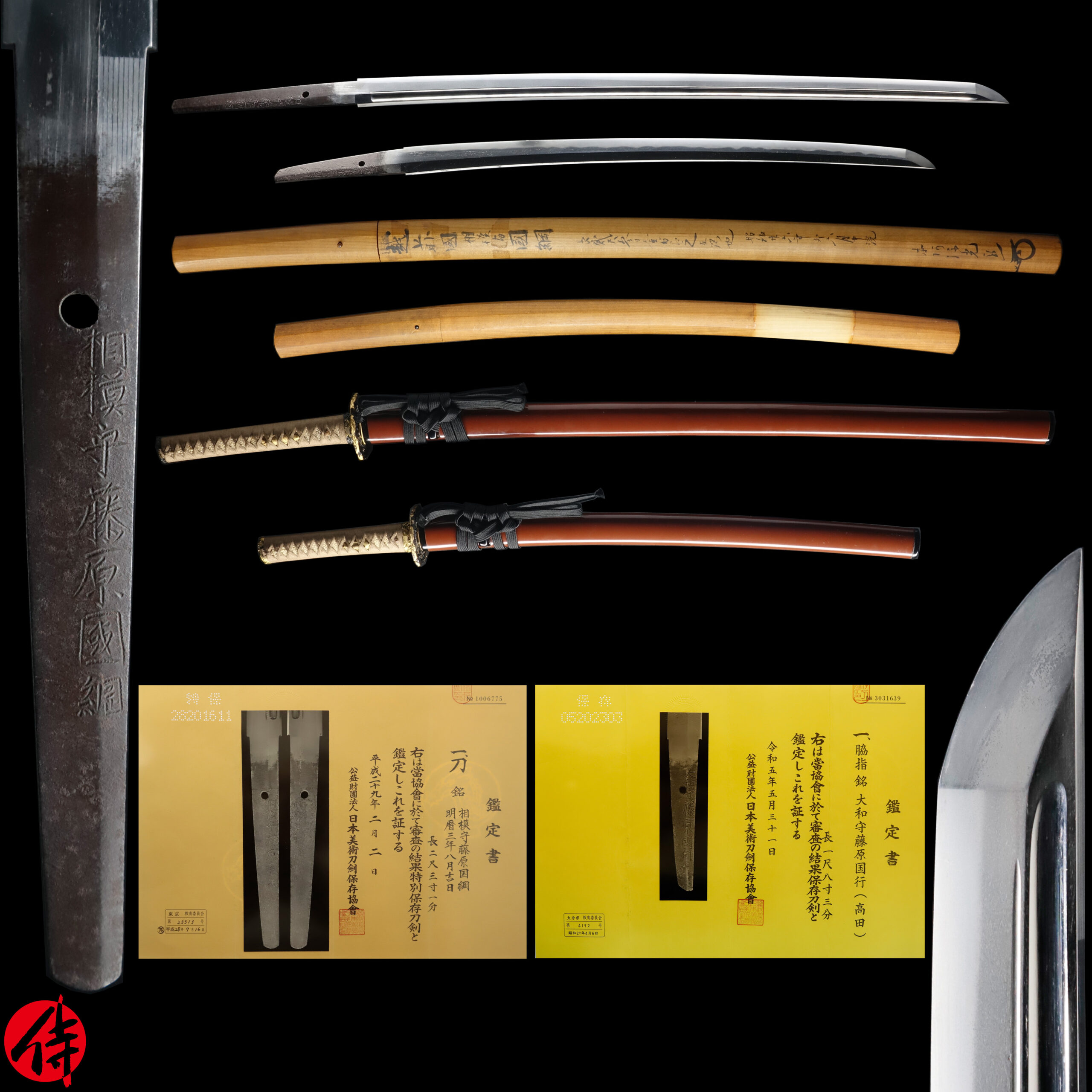
—————————————————————–
【About us】
Samurai Museum is located in Tokyo, Japan, exhibiting antique artifacts related to the Samurai history. Samurai Museum Shop is the place for those who are interested in Japanese culture and craftsmanship. We deal with antique Samurai swords/armor, traditional crafts made in Japan and so on.
【Japanese Sword& Export Process】
The Japanese swords we deal with are hand-forged edged swords made in Japan. It was made from the traditional carbon steel called TAMAHAGANE(玉鋼). Samurai Museum is familiar with the proper legal procedure for an antique/ authentic Japanese sword to be exported from Japan. We have sent more than 700 Japanese swords for the past few years (~2024) to amazing owners who appreciate its historical value.
Each Japanese sword is registered under the Agency for Cultural Affairs and the Board of Education in Japan. They issue a registration paper for each Japanese sword for its owner in Japan to legally possess it. The Japanese sword with its registration paper means it was traditionally hand-forged in Japan.
To legally export the sword from Japan to other countries, we will have to apply for its permit to the Agency for Cultural Affairs(Bunkacho) and return the original registration paper to the Board of Education. It normally takes around 2-4 weeks to receive this permit after submitting required documents. And we would like you to expect at least 1-1.5 months for your order to arrive at your given address after you ordered. For more detailed info, please click here.
It is allowed for residents in Japan to own authentic Japanese swords without a special license as long as they come with registration papers. Please feel free to contact us if you are a resident of Japan, whether temporarily or permanently. We will also assist you when you leave Japan and need to obtain the export permit.
【Payment Method】
We accept payment through Stripe (Credit card), PayPal, Apple Pay or ChromePay, all of which are secure payment methods. Also, you don’t need to make an account on Stripe for the checkout. If you prefer other payment method, please contact us. After confirming your payment, we will apply for an export permit. You may either pay in JPY, USD, AUD, CAD,EUR CHF or GBP. The price is set in Japanese Yen. Prices in other currencies are automatically calculated based on the latest exchange rate.

* If the amount is above 1 million JPY, Stripe or wire transfer will be the only options for payment.
【Shipping】
We have shipped authentic Japanese swords to the USA, UK, Canada, Mexico, Germany, France, Hong Kong and Australia. If you don’t live in these countries and like to order, please contact us first before making a purchase. We offer Free International Shipping as long as we can send antique Japanese swords by EMS.
We normally ship by EMS(Express Mail Service) provided by Japan Post. We will send you a tracking number for your order as soon as we hand it to the post office. We will put 100 % insurance on the shipping document without any extra charge. Based on the total amount, there might be a duty tax or other fee for you to pay, depending on the countries. We use package cushioning to protect the item and put it in a PVC pipe, which is one of the most secure packages because of its durability.
It will normally takes 5-14 days for the item to arrive at your given address after we dispatch it. Time of delivery is estimated as accurately as possible by the carrier but does not take into account any delays beyond our control such as by inclement weather, post office holiday seasons.
* If you live in Australia and like to purchase an authentic Japanese sword, please click here to know the detail.

【Review】
Here is one of the reviews we received from a customer who purchased an authentic Japanese sword from us. For more reviews, please click here.
“My experience overall with the whole process was wonderful. I had many questions about the history and process to purchase these treasures. All my questions were answered very timely and complete. The staff is very knowledgeable and very well versed if any questions do arise.”
【How to make sure the condition】
Please keep in mind that what you are going to purchase is an antique item. We uploaded high resolution photos for you to check its condition thoroughly. If you like to see more photos with different angles, please feel free to contact us. We will be happy to send them to you so that you can make informed decision. It is essential for us to know that you are happy with your choice of a sword. and we are prepared to use the best of our ability to serve you.
【How To Contact Us】
Please contact us through email, Facebook Messenger or Live Chat if you have any questions. You can find each icon on the right side of the website. Please click one of them to reach us. We will reply to you within 1-2 business days.
【The Art of Nihonto (Japanese Sword)】
Samurai’s history is a profound, eloquent legacy of ancient Japanese warriors in which millions of people worldwide are being fascinated. If you like to find out the art of Nihonto, please click here.
【A Guide to Japanese Sword Maintenance】
After acquiring an genuine Japanese sword, it is also important to know how to take good care of it. Here is the special video for you. Mr. Paul Martin, Japanese sword expert, shows you how to give proper maintenance to your sword. By mastering how to clean the Japanese sword, its aesthetic beauty will last forever.
When you purchase a Japanese sword from us, you can get a Free Japanese sword maintenance kit. It comes with four tools(Choji Oil, Uchiko Whetstone Powder, Peg remover, Oil Applicator). By watching the video instruction above , you can enjoy learning how to maintain your Japanese sword while appreciating it. If you have any difficulty assembling the sword or cleaning the blade, you can feel free to contact us.


MORE ANTIQUE JAPANESE SWORD FOR SALE
SWORDS WITHOUT CERTIFICATES FOR SALE
LEARN JAPANESE SWORD TERMINOLOGY
Thank you for reading all the information on the page. If you have any difficulty choosing the right Japanese sword for you, we will be more than happy to help you find the one that speaks to you the most. Please feel free to contact us.
